迈向“零碳”校园
——一个聚焦于柏林工业大学的泛欧洲校园联盟
2015-12-19马丁克里格尔巴巴拉芒奇克劳斯斯蒂芬克劳斯崔里希
马丁·克里格尔 巴巴拉·芒奇 克劳斯·斯蒂芬 克劳斯·崔里希 (德)
林波荣 郑晓笛 曾 颖 李思遥 [译]
迈向“零碳”校园
——一个聚焦于柏林工业大学的泛欧洲校园联盟

马丁·克里格尔(德国柏林工业大学)
Martin Kriegel, Technische Universität Berlin, Berlin, Germany

巴巴拉·芒奇(德国柏林工业大学)
Barbara Münch, Technische Universität Berlin, Berlin, Germany
马丁·克里格尔 巴巴拉·芒奇 克劳斯·斯蒂芬 克劳斯·崔里希 (德)
林波荣 郑晓笛 曾 颖 李思遥 [译]

克劳斯·斯蒂芬(德国柏林工业大学)
Claus Steffan, Technische Universität Berlin, Berlin, Germany

克劳斯·崔里希(德国柏林工业大学)
Klaus Zillich, Technische Universität Berlin, Berlin, Germany
[译者] 林伯荣 郑晓笛 曾 颖 李思遥(清华大学)
[Translator] LIN Borong, ZHENG Xiaodi, ZENG Ying, LI Siyao, Tsinghua University, Beijing, China
马丁·克里格尔(Martin Kriegel)教授多年从事规划、项目管理建筑技术等领域的研究与实践工作,2011年起担任柏林工业大学Hermann-Rietschel-Institut负责人,2013年起担任柏林工业大学能源学院(Institute for Energy) 主管。
巴巴拉·芒奇 (Barbara Münch) 是德国柏林工业大学建筑系讲师,多年从事节能建筑和可持续城市发展、遗产保护等领域的教学和研究工作,曾在清华大学和北京建筑大学进行教学和研究工作,并发表多篇关于中国建筑与城市发展的论文。
克劳斯·斯蒂芬 (Claus Steffan) 是德国著名建筑师,现为柏林工业大学规划与建筑环境学院副院长、教授,并任慕尼黑PSA Architects事务所负责人。他长期从事可持续建筑领域的研究与实践,曾在德国慕尼黑美术学院、美国麻省理工学院等学校任教。
克劳斯·崔里希 (Klaus Zillich) 是德国著名建筑师,1989——2012年任柏林工业大学建筑系教授。他1996年获得柏林建筑奖;2010年主持唐山北郊污水处理厂更新设计研究。 2014年起,他与本文另三位作者一道发起并组织了一项泛欧洲可持续校园联盟研究。本文就是该项研究部分成果的汇总。
来源:作者提供。
Received Date: February 27, 2015
一、概述
本文展示了大学校园如何作为气候创新的引擎并成为生态创新与低碳设计的试验平台。
众所周知,世界正在遭受气候变化和自然资源枯竭的折磨。建筑行业贡献了全球能源领域CO2排放量的30%~40%,消耗了全世界能源的40%。与此同时,建筑行业也成为缓解该压力的最为经济有效的领域[1-3]。对城市规划师与建筑师而言,致力于减缓气候变化和自然资源枯竭成为一项重要的任务。然而,他们无法仅依靠自身来完成这项工作。解决这样一个巨大尺度的问题,需要一种创新的跨学科途径,不仅把不同学科领域内最优秀的人聚集在一起,还可以将政府、公共机构、科学家、企业和公众等社会不同领域组织在一起。此外,为了达到既定目标,这种方法不能局限于某一国家之内,而是需要建立一个强大的国际网络,以使知识得到共享与互换。只有如此,可持续发展才可以加速,快到足以及时地应对气候变化和自然资源枯竭。
大学校园本身就是个小城市。它们是运用综合跨学科途径的最佳环境,因为这里不仅拥有所有学科中最聪慧且最具创新思想的人才,还与政府、公共机构、公司和其他科学家联系广泛。在这里,未来的一代接受教育,他们将更多地受到由气候变化所带来的负面影响,并具有尽快找到解决方案的紧迫感。在校园里,年轻的一代在早期阶段就接触到关于气候调节的最先进的研究成果,并养成一种全新的环境意识。这些将帮助他们找到所急需的解决方案来对抗气候变化和自然资源枯竭,以塑造一个更可持续的未来。
在实践中,大学校园作为试验场,也提供了非常有利的条件:校园具有统一的所有权和自我管理的系统,有自己的设备和能源管理体系,有自己的能源供应系统,以及特定的使用对象团体——学生、教师和员工,并在校园内就具有所有必要的专业知识和研究能力。它们可以同时作为培育基地、生活实验室、终端用户、乘数效应者和企业家,从而成为气候创新的范例和领导者。本文将聚焦于德国柏林工业大学校园,详细阐释其作为可持续城市街区试点的范例性特征。
二、论文结构
论文主体内容分为三个章节,由8篇相对独立的文章构成。其中,A部分为一个章节,由题为“作为区域气候创新引擎的泛欧洲校园联盟”的文章构成;B1部分为第二个章节,由题为“2020年能源高效的柏林大学校园”的文章构成;B2部分是第三个章节,由6篇介绍关键可持续技术的文章构成。
跨学科研究的关键是学科交叉。因此,论文主体不仅介绍校园建筑与城市设计的挑战,更聚焦关键性的可持续支撑技术。作为迈向零碳排放校园建设的第一步,这些技术正在柏林工业大学研发。这也是本论文的一大亮点。
三、A 部分
作为区域气候创新引擎的泛欧洲校园联盟可持续校园:发动用户(SCLC)
A Pan-European Campus Network as Regional Climate Innovation Engines Sustainable Campus: Launching Customer (SCLC)
弗朗西斯卡·卡培拉罗 葛简·德·沃克 杰伦·纳格尔
Francesca Cappellaro, Gertjan de Werk, Jeroen Nageld
弗朗西斯卡·卡培拉罗(意大利博洛尼亚大学,意大利国家新技术、能源和可持续经济发展局)
Francesca Cappellaro, University of Bologna / Italian National Agency for New Technologies, Energy and Sustainable Economic Development, Italy
葛简·德·沃克(荷兰代尔夫特理工大学)
Gertjan de Werk, TU Delft, the Netherlands
杰伦·纳格尔(荷兰乌得勒支大学,乌得勒支可持续发展研究所)Jeroen Nagel, Utrecht University / Utrecht Sustainability Institute, the Netherlands
针对明确的重大社会挑战,欧盟发起了若干个知识与创新共同体(Knowledge and Innovation Communities,KIC)。针对重大挑战之一的气候变化,“气候知识与创新共同体”(Climate-KIC)于2011年成立。目前,拥有240多个机构参与的共同体建立了欧洲规模最大的、公私合作的创新型伙伴关系,共同应对气候变化的挑战。该共同体通过在大型与小型、地方与全球、私人、公共与学术领域之间建立创造性伙伴关系,来推动应对气候变化的创新。该共同体由教育、创业和创新三个重要支柱领域组成。创新支柱领域被划分为八个专题平台,其中一个为“实现转变平台”(Making Transitions Happen, MTH)。这些平台向他们的社区发出提交项目意向书的邀请,以启动在其主题范围内的项目研究。所采用的方法是,先从为期约一年时间的小规模“探路者”项目开始,如果成功,可以成长为一个完整的创新项目,有更多的合作伙伴参与,并持续更长的2~3年时间。除此以外,这些专题平台还运行一些“旗舰”项目,它们涉及更复杂、更具整合性的挑战,也有更多的参与团体。本文介绍的是“探路者”项目——可持续校园:发动用户(SCLC)的一些初步成果,并展示了作为项目参与者之一的柏林工业大学的更为深入的案例。据此,对于随后进行的创新项目的应用,我们掀起了面纱的一角,这一项目就是“协同大学校园推动气候创新融入社会”(SUCCESS),目前该项目正处于审核过程中。本文中介绍的两个合作伙伴因其特殊的专业知识而参与其中。如需更多了解climate-KIC的相关信息,请查看网站www.climate-kic.org。
1 背景
我们的社会正不断面临与气候变化和自然资源枯竭相关的新挑战。为获取能源的矿物燃料开采、不可再生资源的消耗、温室气体的排放都会影响到现在和未来几代人的发展。我们越来越需要一种大刀阔斧的系统性创新,将那些不可持续的活动和行为转变为长期的、利于人类福祉与气候友好的系统。我们需要一种跨学科的方法,以应对气候变化引起的各种复杂问题,并加速转变为一个可持续性社会。尽管各种清洁技术不断涌现,然而为了让这些技术走向市场,提高其在经济、环境和社会变化方面进行转换的策略和过程是至关重要的。在这种情况下,一个影响社会变化动态的转变引擎,是走向低碳社会的关键因素。
2 大学校园作为社会挑战的试验平台
大学校园具有创造和发展可持续性系统创新的所有先决条件:智慧的头脑,与政府、公司和其他科学家建立的国际网络联系,足够的空间,以及实现创新所需的设备及未来一代人才。另外两方面重要趋势是:第一,现今,政府和校园所在的当地社区认为大学应该对社会问题提出解决方案;第二,由于能源、水和废物等资源越来越昂贵,且政府的资助逐渐减少,大学希望将自身的运作系统进行优化。建立一个高效的生态创新体系,有助于将大学校园转变为区域气候创新引擎,使其在走向低碳社会进程中扮演重要角色。创建该高效的生态创新体系将促进实质性的转变,涉及到大学及其校园在结构、文化、组织,以及在整个社会中所扮演角色等方面的适应性改变。校园可以进一步加快技术创新在社会中的应用与传播。
本文展示了由几座欧洲校园所推进的可持续性转型提案,这些提案是在欧洲创新与技术学院的气候知识与创新共同体(Climate-KIC)项目的框架下提出的。例如,“可持续校园发动用户”(Sustainable Campus Launching Customer)项目证明了大学作为区域性气候创新的引擎,有雄心在气候创新方面担当重要角色。关于“技术推动型”与“需求拉动型”两种创新模式有效性的讨论广为人知。当前的现状似乎是在校园中采用技术推动型模型,项目目标在于开放校园社区,使其以社会需求作为研究问题的输入并在实验室中进行测试,随后将其应用回城市和社会(图1)。
为了给项目成员中的大学创建一个创新型模型,我们把现有的两种模式相结合。一种是更为传统的(业务)阶段决策模型,将大学中生态系统的特定参与者与过程结合在一起,另一种为美国宇航局技术成熟度水平指示模型,分别如图2和图3所示。
图4展示了项目已开发的大学创新渠道。
在箭头的头部,我们引入了阶段0——显示活跃的社会需求,和阶段10——通过在社会上的传播与采用而实现的某一创新的广泛传播。技术成熟度水平(TRL)被重新定义为创新成熟度水平(IRL)。
其意图是为了动态地标示出不同大学在这一渠道下的不同创新,以简化项目合作者之间知识交流的过程。关于创新及创新推进过程的初步总览信息,可以从以下网址获得:www. sustainablecampus.eu/eplanete/diamonds/。
如需了解关于该项目及其参与者的更多信息,请查看我们的网站:www.sustainablecampus.eu。

图1 / Figure 1校园应如何解决来自于社会的气候挑战的概念图式Conceptual scheme on how the campuses should solve climate challenges of society
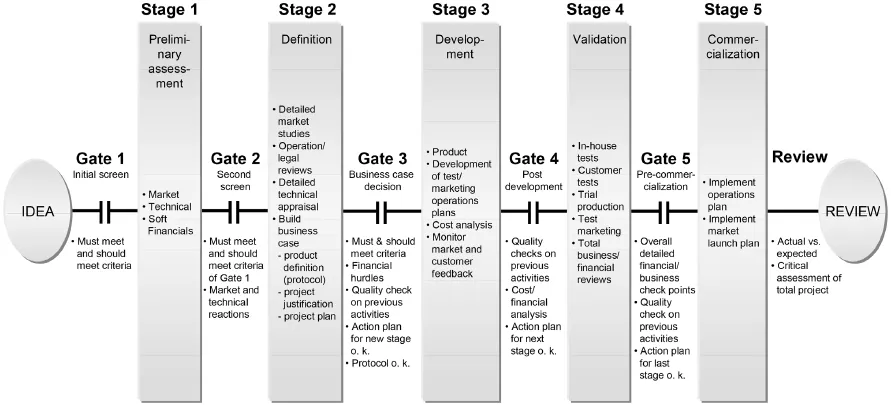
图2 / Figure 2典型的二代阶段决策过程a typical second-generation stage-gate-processCooper et al. 1990, p.46. http://www.tuhh.de/tim/downloads/arbeitspapiere/Working_Paper_12.pdf.
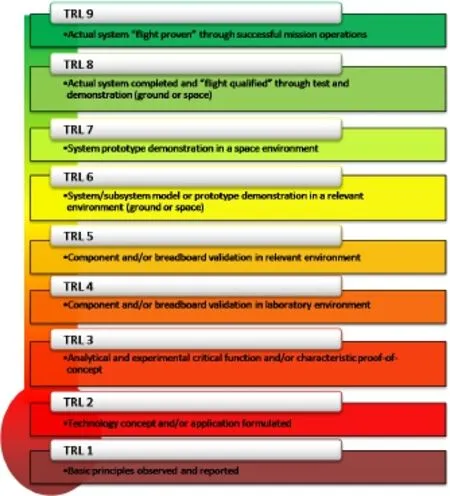
图3 / Figure 3美国宇航局技术成熟度水平NASA Technology Readiness Levelshttp://www.nasa.gov/sites/default/files/trl.png (definitions http://esto.nasa.gov/ files/trl_definitions.pdf).
3 协同大学校园推动气候创新融入社会(SUCCESS)
如上所述,我们想将该创新项目未来计划发展思想的面纱揭开一角。大学校园可以被看作小城市——它们面临类似的挑战,校园问题通常采用城市中的常规方法来进行应对。然而,校园里拥有当前最杰出的头脑,有准备并且有能力面对这些挑战。
我们的目标是创建一个强大的气候创新引擎:一个泛欧洲校园联盟。在该联盟中,通过知识、技能、经验和方法的交流,气候创新在这些校园中得到高效发展。我们将构建实体的和虚拟的基础设施,使这些思想在由需求所带动的气候创新中发挥最大潜能。基于在意大利博洛尼亚的成功经验,该引擎将在由互动转型团队(TTs)管理的向低碳社会的转变过程中发挥强有力作用。自然而然地,随着发动用户将整个地区作为潜在的利基市场(niche markets)而创建了联系,成功的创新将被销售给多所大学。我们将开发一种创新型校园转型工具包,以推进并保持该创新引擎的运转。该工具包的核心要素将包括具有不断扩大潜力的数据库、基准设定、仪表板和评估工具。图5展示了这一气候创新引擎的意向图。
该工具包将被开发成交互式、基于网络平台的工具,以挑选现有的示例策略、产品、生活实验室范例等,通过快速学习、分享、整合并优化气候创新来加速自身校园的可持续策略。图6展示了一个示例模型。
4 从SCLC到SUCCESS,以意大利博洛尼亚大学和瑞典查尔姆斯理工大学为例
在欧洲和世界范围内,自发的可持续校园项目已实现大量增长。所有这些项目帮助大学建立可持续发展原则,并推动校园在日常运营中可持续性的实施。在研究和教育之外,实现可持续性的过程也包括将大学视为一个组织。将可持续发展付诸行动需要不同的、特定的方式。这可以创造一种通用知识,使大学所在社区的众多成员参与其中。通过把所学到的最佳实践、解决方案和经验教训等知识汇集在一起,关键网络系统实现经验汇总,这在成功地将高等教育机构转变为可持续发展之地的过程中至关重要。这一领域无论在技术还是行动层面均具有很大的发展潜力。
4.1 意大利博洛尼亚大学:示范将校园转变为生活实验室
博洛尼亚大学(The University of Bologna)是意大利最大的高等教育机构之一。其特拉茨尼校园(Terracini Campus)展示了一种转型方式,为在转型过程的实际应用层面上可持续性的实现打下基础。该大学已为其自身打造了一个可持续性行动计划。其采用的转型方法有助于校园本身通过采取行动,来发展一种为教学和研究实践服务的反馈机制,同时建立一个强大的可持续性社区。大学层面主动选择研究可持续性还具有另一个优点,即在可持续性的科学领域中、在可持续性转型的理论方面揭示新的考量和贡献。这一示范方法分为战略、战术和操作三个阶段。在战略阶段,博洛尼亚大学为转型管理搭建平台,并在大学层面探讨了其动态性。学校成立了转型工作组,使包括学生、管理人员和教师在内的整个大学社区参与其中。此外,兼顾顶层管理投入、员工及学生参与的做法,为大学的可持续项目提供了最佳机会,无论是在成功的起步阶段还是在远期运营阶段。第二阶段是战术阶段,进一步界定了转型中的挑战以及远期发展的愿景框架。第三阶段为实际操作阶段,下文会进行更为深入的介绍。
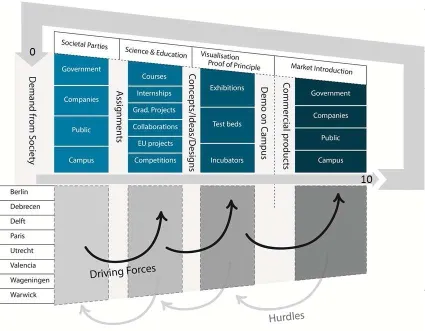
图4 / Figure 4SCLC项目中的大学创新渠道University's innovation funnel in the context of the SCLC project

图5 / Figure 5由校园转型工具包所管理的终极气候创新引擎The ultimate climate innovation engine managed with the campus transition toolkit
4.2 实际操作阶段的专点试验
操作阶段包括两部分:发展小规模可持续议案的行动和实用建议。所有这些转型试验都严格地与加快实施博洛尼亚大学可持续发展行动计划相衔接。在转型过程中,小规模议案被称为转型试验,也被称为“专点试验”(niche-experiments)。当这些“专点”被广泛传播和采用时,它们具有产生突破性成果的可能性。转型试验的运行,可能提高人们的意识并加强利益相关者的参与。通过对可持续校园进程中对象、目标和绩效进行界定,实施可持续发展计划是一种加强和联系现有可持续最佳实践的途径。可持续性计划有助于克服缺点,增强优势。最后,这还创造了一个扩展现有知识并引入新可持续性问题的机会。此外,有一个管理可持续校园的路径值得一提,即国际可持续校园联盟和全球大学领导人论坛(GULF)关于可持续校园宪章(International Sustainable Campus Network, ISCN, 2014)的提案。该宪章以整体方式来应对可持续性为目标,将校园对可持续性的承诺梳理为一个嵌套层次结构,包括单体建筑、全校范围规划与目标设定,以及以可持续性为目标的研究、教学、拓展和设施的整合(图7)。
如图7所示,可持续计划的实施可以成为一个涉及整个大学和更大范围的有益过程。然而,计划过程不仅要对各种活动的可持续性进行监测,还要为来自大学社区及外部利益相关者参与其中创造机会。为此,特拉茨尼可持续发展行动计划包括了技术措施和有助于整合管理活动的附加行动,以增加大学向可持续发展迈进的变革能力。这些行动中还包括为学生创造转型试验室等教育类活动。这是一个特殊的课程,在这里,学生可以在校园可持续发展具体行动的设计中将技术知识付诸实践。另一项附加提案是建立跨学科的团队,来自大学不同院系的教师和研究人员共同关注可持续性主题的研究。这一团队被命名为阿尔玛低碳集成研究组(Alma Low-Carbon Integrated Research Team),有超过160名博洛尼亚大学的研究人员参与其中。学校在可持续发展主题范围内的多学科研究能力得以整合,促进了以科学进步为目标的跨学科路径与战略愿景的发展。
4.3 结论
我们展示了博洛尼亚大学特拉茨尼校园的转型试验平台。案例显示出超越仅对环境性能与效率进行改善的必要性。可持续性提案缺乏与校园现实生活的整合,是限制其达到互相关联更为紧密且持久的局限因素。依据这些目标,在博洛尼亚大学特拉茨尼校园采用的转型管理方式,创造了真正迈向可持续发展的转型机会。我们介绍了其转型之路的发展,包括将可持续发展提案作为可持续性转型的专点试验。转型过程帮助人们提高意识,使其他利益相关者参与其中,并在不同参与者之间创建了新的网络系统。作为结果,一个增强大学向可持续发展迈进转型能力的学习过程得以建立。总体来说,本文论证了在应对可持续发展危机的动态、复杂因素过程中,大学在形成具体解决方案与策略方面可以扮演重要角色。为实现这种期望,至关重要的是把教育、研究和社会贡献无缝地结合成一个整体,然后在制度化过程中将其提升并强化。
4.4 瑞典查尔姆斯理工大学:在校园体验和测试城市地区可持续发展要求
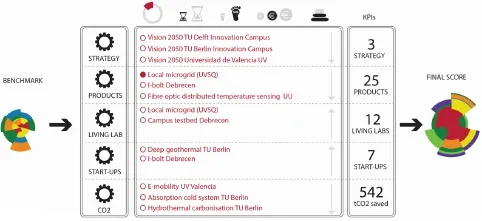
图6 / Figure 6校园转型工具包的界面Interface of the Campus Transition Toolkit
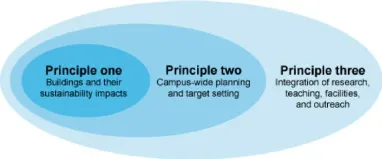
图7 / Figure 7ISCN-GULF可持续校园宪章(ISCN, 2014)的基础原则Basing principles of ISCN-GULF Sustainable Campus Charter (ISCN, 2014)
查尔姆斯理工大学(Chalmers University of Technology)位于瑞典西海岸的哥德堡。学校有12,000名学生和3,000名员工,分布于两个校区。查尔姆斯是一所研究型大学,其工程与建筑学教育及所有的硕士生学位课程处于国际领先地位。约翰伯格科技园(Johanneberg Science Park)隶属于查尔姆斯大学,在这里知识和创新与相关的国家及国际级公司、市政当局和地区紧密结合。约翰伯格科技园被选为Climate KIC旗舰项目“智慧可持续地区”(Smart Sustainable Districts)的核心区域。因此,该地区建立了雄心勃勃的“改进因素10”(factor 10 improvement)愿景。该校园对世界领先的创新者而言,是一个理想的试验场。查尔姆斯大学正处于可持续校园发展进程中。这是由一位副校长领导的校园发展指导委员会和查尔姆斯环境办公室及Fastigheter AB地产公司共同协作进行的。查尔姆斯理工大学最近进行了一次标示建筑可持续性水平方法(BREEAM)的社区测试,涉及校园范围内广泛的利益相关者。其可持续发展目标引导着校园的发展过程。校园发展的一个主要驱动力是绿色通行计划(Green Travel Plan),计划中校园将扩充5,000名新员工,其中很多来自商业与创新领域,但计划中没有新增车辆。正在进行的“因素10”具有很强的包容性,涉及商业与社会中多方利益相关者。在约翰伯格科技园内,一些标志性项目正在进行中,包括雷克斯比艮正面碳足迹住宅项目(Riksbyggen Positive Footprint Housing)和HSB生活实验室等。在创业方面,查尔姆斯有三个组织负责学生教育和创业及创新的市场推广。自2012年以来,基于在教育、研究、创新与内部环境方面的系统性工作,以及教育、研究与校园物质实体的积极关联,查尔姆斯获得了ISO 14001的环境认证。查尔姆斯为SUCCESS项目的理念、创新与工具数据库做出了贡献,并与智慧可持续地区的资源箱建立了联系。该系统工具可以在联盟中的其他大学进行复制。
此外,查尔姆斯理工大学与沃尔沃集团、沃里克与巴伦西亚(Warwick and Valencia)等合作伙伴在低碳汽车等特定领域的合作,将为新型交通工具的进一步研发与测试贡献力量。
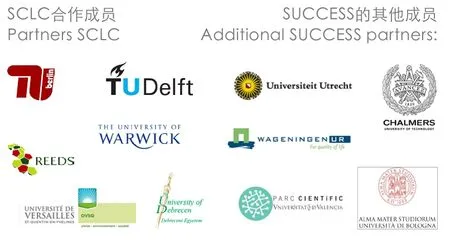
柏林工业大学、代尔夫特理工大学和乌得勒支大学已被指定为试点大学。参见:www.sustainablecampus.eu。
TU Berlin, TU Delft and Utrecht University have been appointed as Pilot Universities. See: www.sustainablecampus.eu.
在研究型大学国际联盟(IARU)最近公布的“大学绿色指南”中可以找到有趣的“生活实验室”途径。
Find also interesting ‘living lab’ approaches in the recent International Alliance of Research Universities (IARU) “Green Guide for Universities”.
四、B1部分
2020年能源高效的柏林大学校园SCLC先锋项目——柏林工业大学
Energy Efficient University Campus Berlin 2020 SCLC Pilot Technische Universität Berlin
马丁·克里格尔 巴巴拉·芒奇 克劳斯·斯蒂芬 克劳斯·崔里希 (德)
Martin Kriegel, Barbara Münch, Claus Steffan, Klaus Zillich
1 介绍
鉴于2011年日本福岛核电站事故之后相继发生的核灾难事件,德国联邦政府已经决定在短期内逐步停用核能,并扩展可再生能源的使用。该项决定被称为德国的“能源转向计划”(Energiewende)。德国联邦政府采取了一项雄心勃勃的“2020/2050能源理念”,以期缓解并适应气候变化。
——2020年 比1990年温室气体排放水平减少40%
——2020年 比2008年能源效率提高20%
——2020年 将能源消耗中可再生能源所占比例提高至18%
——2050年 比1990年温室气体排放水平减少85%~95%
——2050年 比2008年能源效率提高80%
——2050年 将能源消耗中可再生能源所占比例提高至60%
为加速实现这些目标,德国联邦经济与能源局(BMWi)发起了一项研究基金项目,主要内容包括三项研究焦点,即能源高效城市、能源高效校园、能源高效:热量与能源优化建筑。
该项目的重要性基于这样一个事实:德国约40%的最终能源消耗是建筑领域所造成的。同时,建筑领域具有最具成本效益的减排潜力,突显了城市规划师、建筑师和工程师在应对气候变化与自然资源消耗问题上的重要作用。2010年,柏林的CO2排放量为2,130百万吨,其中约47%来自建筑领域。建筑领域是最重要的CO2排放者(见“2050气候中立的柏林”(Climate Neutral Berlin 2050)[4])。
基于“2020/2050联邦能源理念”,柏林大学校园(柏林工业大学和柏林艺术大学)正在申请2015——2020年的BMWi基金,希望将校园打造为示范项目:柏林夏洛腾堡能源高效高校校园(Energy Efficient Hochschul Campus Berlin Charlottenburg),以下简称EnEff: HCBC校园。项目旨在于2020年以前建设生态创新与气候友好的先锋柏林城市街区,甚至设定了比政府项目更大的愿景。参照诸如哥本哈根在2025年将CO2排放量减少100%[4]等相近目标,EnEff: HCBC校园正在制订自身的愿景——“气候地区2020”(Climate Kiez 2020)[4],其更加雄心勃勃的目标包括:100%温室气体减排,100%可再生能源应用,100%能源效率提升。
2014年3月,柏林工业大学加入了上文介绍的泛欧洲校园联盟SCLC“可持续校园发动用户”项目,与荷兰代尔夫特理工大学和乌德勒支大学一起被指定为“试点大学”。
柏林工业大学拥有两位在减缓与适应气候变化领域最杰出的人物。2012年,波茨坦气候影响研究所(PIK)主任约翰·施兰赫伯教授(John Schellnhuber)被柏林工业大学授予名誉博士学位并成为学校一员;奥特玛尔·埃登霍费尔教授(Ottmar Edenhofer)作为PIK成员及政府间气候变化专门委员会的领导成员,在柏林工业大学担任“气候变化经济学”的主任。
2 HCBC校园及其优越的地理位置
HCBC校园是柏林的四个核心城市热点之一。柏林中心城区的肌理结构是由四个关键的交通路口所界定出的四个主要城市中心构成的:动物园/城西,柏林中央火车站/施普雷河湾(北),波茨坦广场/CBD波茨坦/莱比锡广场(南),亚历山大广场/城东。这四处城市中心因首都柏林四个显著的世界级政治、科学与文化机构而闻名:
(1) 夏洛滕堡科学与艺术学校,城西
(2) 施普雷河湾联邦政府论坛
(3) 波茨坦广场附近的文化论坛
(4) 博物馆岛和“执政市长的”市政厅,城东
夏洛腾堡校园尤其具有独特的城市特质:HCBC校园与城市的主要东西轴线“六月十七大道”相交。此外,校园紧临重要的交通枢纽“柏林动物园”,为所在社区提供了完美的公共交通连接,包括一个主要的长途火车站、城市快速列车站、地铁站和柏林中央汽车站。城市核心——“城西”也紧临校园。
120m宽的城市轴线“六月十七大道”与整片校园区域相交,将其切成南北两半。如此一来,柏林工业大学校园的北界面与南界面就面向着首都柏林这一著名的公共空间,为展示和宣传提供了理想环境(图8)。
此外,HCBC校园紧邻柏林市中心城区的绿肺和娱乐区——“蒂尔加滕”及“柏林动物园”,使其成为更加吸引人的场所。考虑到所有这些特有的品质,EnEff: HCBC大学区在可持续性的现代化与城市化方面具有出色的先天条件,注定成为契合的先锋性能源高效城市地区。
3 HCBC的历史与地位
1879年,威廉二世皇帝成立了“德累斯顿工业大学”,即皇家技术学院。该学院由1799年由建筑师卡尔·弗里德里希·申克尔(K.F. Schinkel)创办的著名的建筑学院和与1821年成立的柏林“商学院”合并而成。1884年,学院搬迁至位于夏洛滕堡公路上一个新的、具有代表性的校园建筑,这条公路今天被称为“六月十七大道”(图9)。皇家技术学院专注的科学领域以“机械工程”和“电气工程”为代表。19世纪后十年至20世纪前十年间,在柏林工业化向着著名的柏林“电气都市”前进的路途中,该学院成为主要支柱之一。老“德累斯顿工业大学”的建筑尽管在第二次世界大战中被部分损毁,但经过修复目前仍是柏林工业大学的主要代表建筑,承担着校长办公、行政机关、奥迪中心和大型校园文化空间等功用。
今天,EnEff: HCBC校园的特点在于高建筑密度。校园中有大约50栋不同尺度、年代和功能的建筑,提供了总计约60万m2的净建筑面积。学校现有5万人,其中学生数量为4万。
柏林工业大学设备管理部门表示,校园建筑整体目前面临着巨大的更新需求,特别是其能源效率问题,涉及超过3亿欧元的资本。
校园东侧是柏林工业大学/柏林艺术大学及城西/柏林动物园的“后院”,可以提供15万m2作为新城市中心的可持续建筑空间,潜力巨大。由于其大部分区域归属于柏林工业大学和柏林艺术大学,因此该场地完全可以成为科学与经济、研究与项目启动、学生生活与商务公寓之间的接口。
4 挑战
“无论在最好或最坏的情况下,我们的国家都将会成为从化石燃料——核能向高效可再生经济转变的全球模型。但是如果没有德国最大城市的推动,这样的转变将不会以一种精彩的方式取得成功。”[4]——约翰·施兰赫伯教授
5 目标
EnEff: HCBC校园将被作为德国“能源转换计划”的先锋进行发展与宣传。其核心目标是在2020年成为100%温室气体减排、100%可再生能源应用、100%能源效率提升的校园。为实现这些远大目标,EnEff: HCBC校园将转变为“能源增值区”,即一个综合使用多种创新节能技术的能源生产商。它将因此而成为育种场、试验场和气候创新的引擎——一个柏林“气候地区”的蓝本。[4]
在实操层面,学校具有成为可持续城区发展范例的有利条件和特点。下列事实促进了试点工程的实施:学校拥有统一的所有权、一个被推举出来的科学统领、一个能源供应系统、一个设备与能源管理部门,一个由学生、教授、职工组成的用户群体,一个由最杰出的人才和科学家所组成的知识网络,一个求知若渴的学生群体。
为达成上述规划目标,以下的重点领域被确证是至关重要的。
5.1 建筑结构
大学校园通过一种彻底的可持续方式来更新现有建筑,在节约能源和减少CO2排放方面具有很大潜力。EnEff: HCBC校园将以最可持续的方式来开发并改善现有建筑的潜力。在城市尺度上,校园的东部将进行可持续的创新性城市设计,包括便捷的步行距离、高密度和良好的公交系统可达性等。所有新建筑的设计都会重点考虑能源效率和资源保护。
5.2 能源生产
HCBC校园作为能源生产商,将基于对场地中可利用的可再生能源的应用,使用一系列创新节能的工厂技术,如太阳能、深层地热、计算机中心与礼堂等产生的废热、植物废料、动物/大象粪便、污水等。此类关于城市区域能源生产的宏大愿景可以参见两个先进范例:一是位于德国阿伦多夫市的生产性校园、由菲斯曼集团执行的战略性可持续项目“效率增值”总部[5];二是2011年emhz建筑事务所在中国唐山进行的“城市基础设施向城市公共空间的转型”可行性研究[6]。
5.3 改变用户行为
25%的能源消耗都是由错误的用户行为所导致的。因此,多种手段与实践将进行开发和测试,以激励学生、教授、行政职员等校园使用者以一种负责任的方式参与其中。
6 执行策略
EnEff: HCBC校园期望在2020年达到德国联邦政府2050年的目标。
2013年,HCBC校园的最终能源消耗总共达到100千兆瓦时,相当于140千兆瓦时/年的初级能源消耗。
到目前为止,HCBC校园的能源部门做到了持续改进校园中能源与环境的平衡关系,这是通过在可持续发展中的积极参与和完成主动能源控制系统来实现的。它正在不断减少能源消耗,逐步实现新的“能源总体规划”。
作为实现EnEff: HCBC校园项目的第一步,我们将推动下列相互关联的项目活动。这些活动部分基于当前已有技术,部分基于新开发的创新技术,部分基于对现有建筑结构的节能更新和新建筑的节能建造。活动还包括动员校园使用者通过改变其使用行为来节约能源,从而支持校园的可持续性改变:
——原型解决方案的研发,并展示先进的“建筑——能源——系统”与节能抗噪建筑表皮的结合/“柔声气候围护结构”(Soft Sound Climate Envelopes)。
——校园区域、建筑群和单体建筑层面的跨学科试点与示范项目,聚焦于“零能耗”整修(如数学楼,图10~12)、节能建筑体量扩大(如柏林艺术大学主楼的屋顶,图13)、生产能源的新建筑即“能源增值建筑”(如校园东区,图14、图15),以此将校园转型成进行可持续性建设与运转的学习、研究和实验场。
——通过“BNB”(联邦可持续建筑证书)对实现节能与“能源增值”校园建筑的杰出模型进行认证。
——针对整个校园的创新性“热量——能源——管理”体系,将评估系统的范围从单体建筑转向整个HCBC校园。
——校园内创新节能设备技术的落实,可将其与多功能建筑进行集成以成倍增加有限空间的利用价值[6,7],或将其作为独立的样板来展示(图16)。
——绿色校园学生活动,例如,学生提案DAEJAYON[8]:在HCBC校园内实现节能奖金模型,向所有校园使用者推广“绿色法典”。又如,通过国际学生交流与合作项目,针对气候问题进行知识交流并提高认知。
7 合作伙伴关系
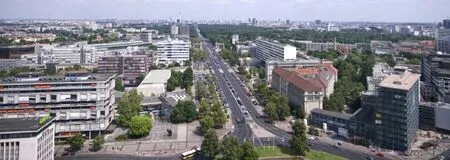
图8 / Figure 8HCBC校园被主要城市轴线穿过——“六月十七大道”HCBC Campus crossed by main city axis “Straße des 17. Juni”

图9 / Figure 9皇家技术学院Royal Institute of TechnologyMax Lübke于1885年左右绘制,柏林工业大学档案 / Drawing by Max Lübke undated, around 1885, Archive of TU Berlin
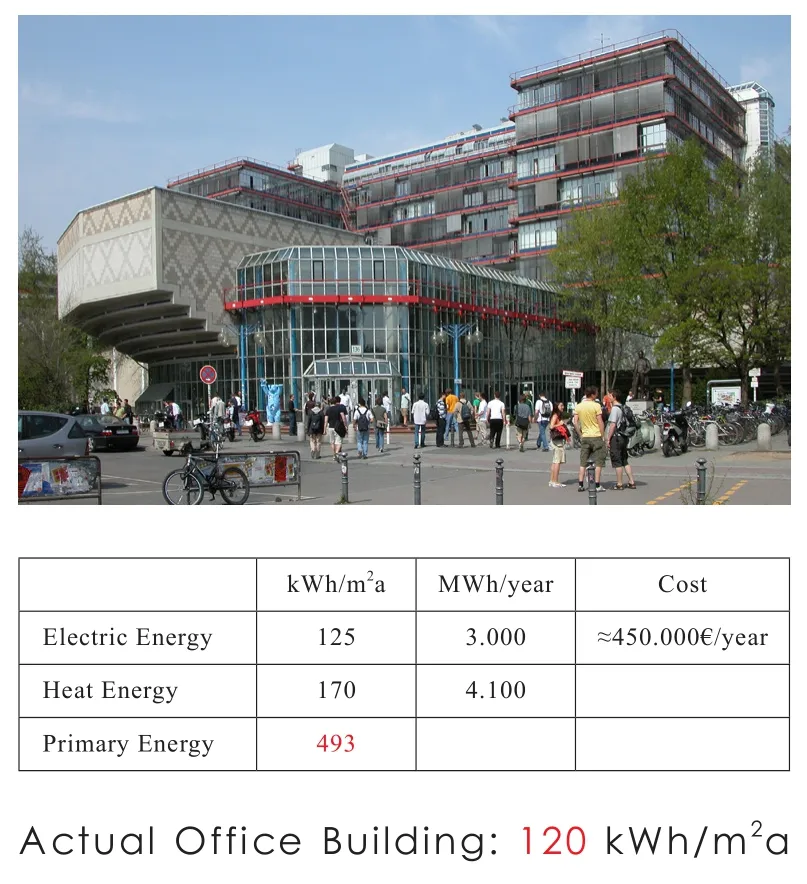
图10 / Figure 10柏林工业大学数学楼南立面,六月十七大道上的视角Mathematics Building, TU Berlin, South facade, View from "Straße des 17. Juni"https://www.math.tu-berlin.de/fileadmin/i26/Bilder_ Webseite/2007-04-17_Mathegeb_ude.jpg.
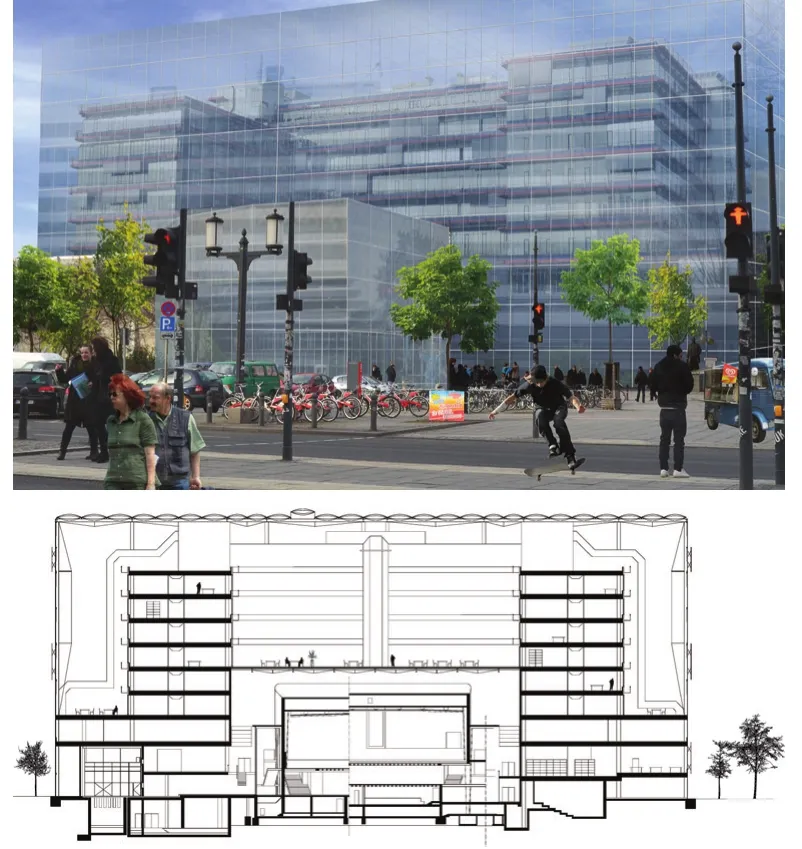
图11 、图12 / Figure 11 & 12学生Annika Falkstedt的课程设计,研讨课“新”(Neu),数学楼的活力与功能更新,GtE Claus Steffan教授主持Project by student Annika Falkstedt, Seminar, "Neu", energetic and programmatic renewal of the Mathematics Building, Chair GtE Prof. Claus Steffan
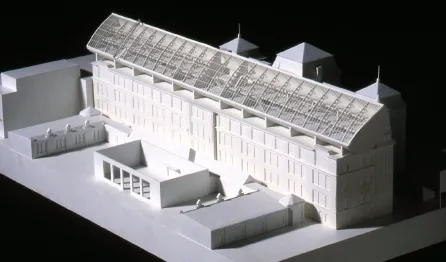
图13 / Figure 13柏林艺术大学的屋顶加建项目:建筑师Ernst & Zillich的获奖设计Rooftop Enlargement UdK: Winning Project by Architects Ernst & Zillich Ernst和Zillich拍摄 / Photo by Ernst & Zillich

图14 / Figure 14学生Violetta Kumsta的课程设计:沉碳校园,2011年柏林工业大学与柏林艺术大学的学生设计研讨课,联合主持:Nytsch-Geusen教授(柏林艺术大学)、Klaus Zillich教授(柏林工业大学)Project by student Violetta Kumsta, Carbon Sink Campus TU/UdK, Student's Design Seminar TUB/UdK 2011. Chairs: Prof. Dr. Nytsch-Geusen (UdK) / Prof. Klaus Zillich (TUB) Violetta Kumsta绘制 / Visualisations by Violetta Kumsta.

图15 / Figure 15学生Violetta Kumsta的课程设计:沉碳校园,2011年柏林工业大学与柏林艺术大学的学生设计研讨课Carbon Sink Campus TU/UdK, Student's Design Seminar TUB/UdK 2011 Violetta Kumsta绘制 / Visualisations by Violetta Kumsta.

图16 / Figure 161974年兰德韦尔运河洛克岛上的循环水箱Water Circulation Tank on the Landwehrkanal lock island 1974建筑师路德维格·利奥Architect: Ludwig Leo
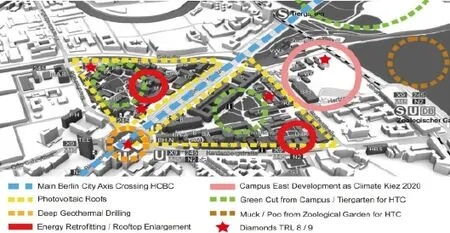
图17 / Figure 17柏林夏洛特堡HCBC Hochschul校园,柏林工业大学与柏林艺术大学作为“气候地区”柏林2020The HCBC Hochschul Campus Berlin Charlottenburg, TUBerlin and UdK as "Climate Kiez" Berlin 2020 Martin Kriegel, Klaus Zillich, Claus Steffa. EnEff_HCBC_Präsentation_2014_04_08.
EnEff: HCBC作为首都柏林先锋校园的成功实现,需要强大广泛的伙伴关系与合作。因此,大学、研究机构、联邦政府(BMWi)、柏林市和私人公司之间的合作是必要且颇具前景的。
科学和商业领域的合作伙伴包括:
——PIK 波茨坦气候影响研究所
——GFZ 波茨坦地学研究中心/储层技术/深层地热能
——MPIKG 马普胶体与界面研究所
——普利德曼表皮实验室
——GASAG 柏林燃气集团
——海瑞克深层钻探研究部
8 关键性可持续技术(钻石DIANOND)
如上所述,我们需要一个跨学科的、高整合度的途径以实现HCBC校园项目设定的宏伟目标:100%温室气体减排,100%可再生能源应用,100%能源效率提升。一个关键问题是识别与开发场地内本地已有的可再生能源的新来源,比如太阳能、地热能、生物质能(校园或公园里的植物废料、附近动物园的动物粪便),计算机中心、实验室与礼堂所产生的废热等。与此同时,需要开发新的先进技术来提高场地上可利用可再生能源的转化、储存与分配效率。
在后续的“详解”章节中,我们将更详细地介绍6个被选中的关键性可持续技术,即“钻石”(DIAMOND)。所有这些关键性可持续技术都是柏林工业大学及其合作伙伴的研究项目,也将会成为EnEff: HCBC校园2020年全局策略的一部分。
——整合采暖、制冷和电力的吸收式制冷机
——ATES:含水层蓄热
——深层地热能
——HTC:水热碳化
——LowExTra:低能耗区供热与制冷
——Watergy:来自城市温室的热量供给
五、B2部分
关键可持续技术1 – Diamond 1
用于热电冷三联供的吸收式冷机
Absorption Chillers for Combined Heating, Cooling and Power
斯蒂芬·彼得森 菲利克斯·齐格勒
Stefan Petersen, Felix Ziegler

菲利克斯·齐格勒(德国柏林工业大学)
Felix Ziegler, Technische Universität Berlin, Berlin, Germany
斯蒂芬·彼得森(德国柏林工业大学)
Stefan Petersen, Technische Universität Berlin, Berlin, Germany
在德国、瑞典、丹麦、芬兰等欧洲国家,超过25%的采暖需求通过集中采暖的方式来达成。在一些北欧国家,这一比例甚至超过70%[9]。在一些月份,欧洲的绝大多数集中供热系统都是在低负荷率状态下运行。而另一方面,空调的制冷需求却在持续增加。在夏季,低温驱动的吸收式冷机可以采用集中供热提供的热量来制冷。通过这种方式,集中供热网络的效率可以得到提升,集中供热的供应商可以开拓一个新的市场,冷机的运行可以依靠一个廉价、可靠、生态的动力来源[10,11]。当热量来自于工业余热、发电废热或者太阳能光热时,吸收式制冷技术是一种被广泛运用的节能制冷装置。
由柏林工业大学(TU Berlin)运行、ZAE Bayern提供技术支持、Vattenfall Europe提供技术合作、德国联邦经济技术部提供赞助的研究和技术开发示范项目已经启动,这个项目的主要目的是研究50~320kW的高效吸收机。项目的二期工程继续由柏林工业大学运行,德国机构AGFW、BTGA、TU Dresden和ILK Dresden提供支持,德国联邦经济技术部提供赞助。
该项目主要研究高效的制冷过程,包括散热、水力部件(及由此导致的能耗需求)以及控制。制冷量范围在50~320kW,这对应于一个中等规模的住宅区。所以第一步是,在几个示范点设计、制造和安装50kW的冷机。之后,160kW的设备被研发出来。这两种机型的名字分别是Bee和Bumble-Bee,现已在德国境内的16个试点地区进行过现场测试。
冷机设计工况是可以在25%到140%的额定负荷之间,以不高于0.8的热COP运行。此外,即使负载率低到5%,它依旧能够稳定运行。
当驱动热源的入口温度在55℃到110℃之间变化时(标准的运行工况是供回水温度分别为90/72℃),冷却侧入口温度不超过45℃是可行的。第一台50kW机组的热物理性质在2011年的一篇文献里已有阐释[12]。
这套新研发机组的另外一个重要概念是它可以用干冷机组来冷却。排热温度新的基准线已经被确定,高排热温度下不存在结晶问题。部分负荷下,理论上可以节省排热循环的泵耗(如图19所示)。在欧洲季节能效比(ESEER)的定义中,大约40%的时间机组运行在50%的额定容量下。如果水泵的效率是一定的,那么通过减少部分负荷下的冷却水;流量,可以实现多达98.5%的水泵节能。此外,如果采用合适的控制策略,同步减小冷却塔风机的转速可以实现80%~90%的节能潜力。
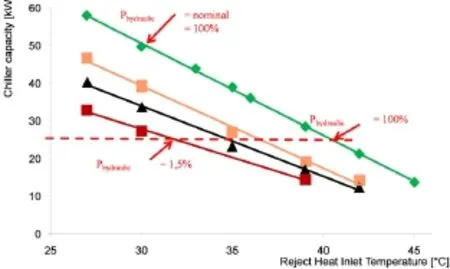
图18 / Figure 18冷凝热变化范围Reject heat variation
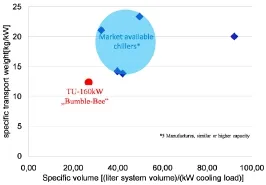
图19 / Figure 19吸收式冷机特征容量基准线Specific sizing benchmarks of absorption chillers
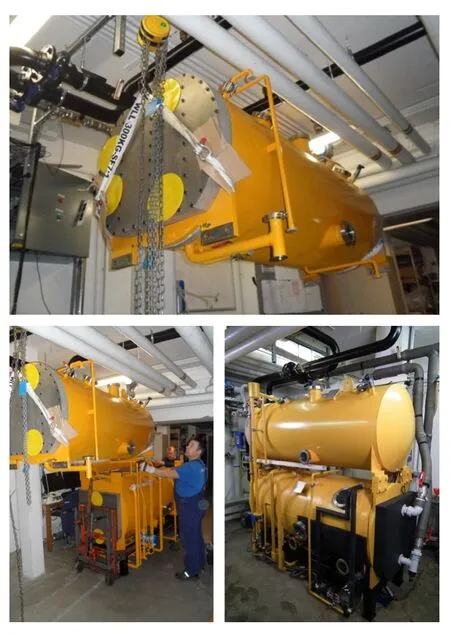
图20 / Figure 20模块化160kW机组“Bumble Bee”modularized 160 kW "Bumble Bee"
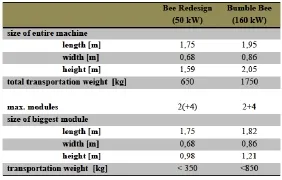
图21 / Figure 21吸收式冷机的尺寸Geometrical data of absorption chillers
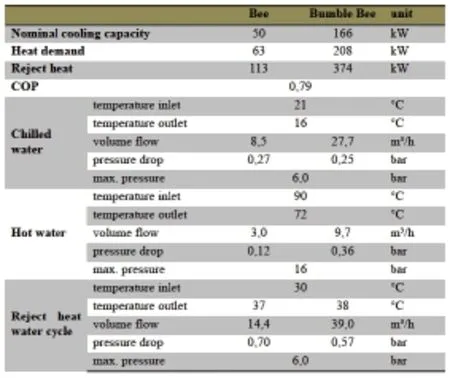
图22 / Figure 22吸收式冷机的额定工况Nominal conditions of absorption chillers
采用和强化50kW机组换热器的概念,可以建立160kW机组的换热器概念。主要目的是确保冷机和冷机模块的重量小于1000kg(方便运输),尺寸控制在1.9m×1.6m×0.88m(以便顺利通过门和拐角)。最终,新的设计理念量化到数字中,在图21的表格中得以体现。就像图18~20所展示的,这一概念可以把冷机拆分为两个主要模块,包括两个主要的换热器、低压增发器、吸收器、溶液换热器、水泵、基座和用于盛放解析塔和冷凝器的高压容器。
图21将这一冷机和市场上主流的冷机进行了对比。即使作为一个整体的系统,它仍然比圆形组装的“一体式”的市场主流产品更轻更小。一体式冷机是不能拆分的,无论是重量上还是体积上。为了能够通过门,作为一个整体,只有采用这个容量下最小的冷机,才能把它控制在0.86m的范围之内。更重要的是,初步的经济分析指出这套系统可以比市面上现有的产品便宜50%~70%。
图21归纳了这套新型吸收式冷机的几何尺寸,图22总结了这两种设备的额定工况。
本章描述的产品研发展示了将一种看似成熟的科技进一步现代化的可能。吸收式冷机或者热泵在电气化时代不是一个主流市场。在近期广泛讨论的能源末端利用效率、太阳能利用和热电联产的背景下,吸收式冷机使得在夏季使用余热成为可能,通过这种方式,可以增加热电联产的使用率,同时减小由于压缩式制冷导致的额外电量需求。
致谢
作者感谢德国联邦经济与能源部(German Federal Ministry of Economics and Energy)的支持项目Project Management Jülich (PTJ)。
关键可持续技术2 – Diamond 2城市含水层的季节性蓄能的效率和可靠性研究
Efficiency and Reliability of Energy Systems in Urban Districts with Seasonal Energy Storage in Aquifers (Aquifer Thermal Energy Storage - ATES)
斯蒂芬·克朗兹 阿里·萨阿达特 亚历山大·尹德福斯 福克·库多克
Stefan Kranz, Ali Saadat, Alexander Inderfurth, Falk Cudok
未来城市的能源系统要求使用高效率的能源技术以及对于可再生能源更多的分享。由于完全的节能潜力,不同时间尺度上的能量存储非常重要,其主要原因在于可以弥补能源需求和能源供给间的时间差异。对于建筑密度高的城市地区,大存储容量是有利的,地下含水层就是特别合适的存储设施。不少案例很好地证明了这一点,例如在荷兰相对较低的温度(10~40℃),再比如在德国一些个人的试点项目可以得到更高的、达到80℃的温度。
此项技术方面为取得更进一步进展,一个新的研发项目正在启动,其主要目是针对现有或未来的市区能源系统,开发可以使含水层跨季节蓄能的更可靠和更有效的设计方法。这个项目涉及来自多个专业的专家和学者。其中,有来自柏林大学艺术学院城市和建筑能效领域的专家,也有柏林技术大学水文地质、地热技术领域的专家,还有来自国际地热研究中心德国地球科学研究中心地下热能存储技术的专家。项目的主要案例是柏林工业大学校园。校园中由共有49栋建筑,分别用作办公室、讲堂、实验室等功能,建筑的建设年代从1883年至今跨越了一个多世纪。
1 含水层储存热能的工作原理
在ATES系统中,水轴承砂岩是热能的存储介质。地下水是同样被作为传热介质和存储介质。一般的ATES系统包含两口井或者多口井。图23中,蓝色的为冷水井,红色的为热水井。ATES系统用于季节性的存储热能,主要功能是加热和冷却建筑物。ATES系统储存热量时,从冷水井出来的地下水在表面被加热,然后通过热水井注入含水层。在释放能量时,能流方向逆转,微热的地下水从热水井被抽出,在使用热量时被冷却,再通过冷水井注入含水层。
2 存储集成和能量系统分析季节性蓄能设计的主要目标是优化能源的供求关系和储存系统,需考虑可靠性和安全运行。一项存储设计的开发中,多个影响因素必须被考虑。一方面,最相关的因素包括地质结构、流体化学、微生物学和含水层的水力及热力储存性质;另一方面,有一些因素取决于表面能量系统,如多少能量可以用于充电或放电,还有地下水循环量、温度及时间行为的系统组件和需求等方面。为了优化并整合区域能源系统,设计和规划方法需要考虑建筑物、能量转换技术和ATES系统。
3 ATES系统的地球化学因素
利用深层地下水含水层作为能量储存的方式可能与化学或微生物产生相互作用,最后可能导致存储性能的降低。这些反应可以由改变温度或地下水与大气中的氧气接触而触发。为减少储存性能降低的风险,需要对含水层特性和溶质输送性能进行调查和研究,并考虑现有的可能操作条件。基于这些结果,可以认定温度变化对渗透系数的影响,并确定操作中的温度限制。这一调查包括实验室研究和现场实地测试,过程中使用数值模拟进行支持。其结果对于蓄能运行的可持续性与可靠性都是至关重要的。

斯蒂芬·克朗兹(亥姆霍兹波茨坦中心德国地学中心——GFZ)
Stefan Kranz, Helmholtz Centre Potsdam GFZ German Research Centre for Geosciences, Germany

阿里·萨阿达特(亥姆霍兹波茨坦中心德国地学中心——GFZ)
Ali Saadat, Helmholtz Centre Potsdam GFZ German Research Centre for Geosciences, Germany

亚历山大·尹德福斯(德国柏林艺术大学)
Alexander Inderfurth, Universität der Künste Berlin, Berlin, Germany
福克·库多克(德国柏林工业大学)
Falk Cudok, Technische Universität Berlin, Berlin, Germany
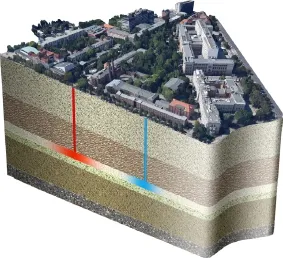
图23 / Figure 23在柏林大学校园的含水层存储热能的综合能源系统(使用谷歌地球模型)Aquifer thermal energy storage for heat integrated in the energy system of the University Campus in Berlin (modified Google Earth)
4 能量转换技术
在本项研究中,热电联产单位、压缩制冷机、压缩热泵、吸收式热泵、吸收式制冷机、吸收热量变压器等能量转换设备被列入研究范围。研究的重点是吸收式热变换器技术。这里将开发、搭建并实验分析一项新的组件。吸收式热变换器(第二类吸收式热泵)可以像吸收式热泵、吸收式制冷机和吸收热量交换器一样被使用。由于具有很大的可调节性,该类热转换器是一种很有前景的城市集成冷热供应系统技术。
图24显示了一座应用ATES系统进行集中供热和制冷的城市的可能场景。在夏季,该热变压器在吸收式制冷机运行模式下运行,与此同时,ATES系统像水槽一样存储余热;在冬季,热泵运行方式或加热变压器模式被启动,ATES系统作为热源进行供热。
5 建筑和城市街区
该项研究提出了一个普适的模拟方法。这一方法可以建立囊括整个街区众多建筑和通用能源供应网络的热表现模型。该模型旨在寻找足够精度和最短中央处理时间之间的平衡。因此,更快速、更简化的组件被使用。该模拟方法将被应用于柏林工业大学校园不同案例的分析之中。图25显示了校园中所有建筑物的年度耗热量。
致谢
这个项目是由联邦经济和技术部(BMWi 03ESP409A)提供资金支持。我们感谢相关部门对我们在资金上的大力支持。
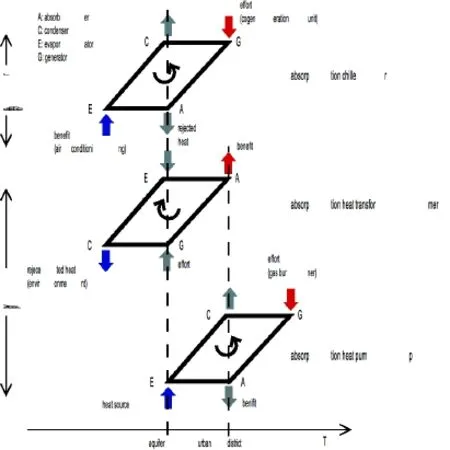
图24 / Figure 24假设可能的场景——连接市区的含水层和吸收式热变换器集成加热系统Possible scenario of an integrated heating system of an urban district in connection with an aquifer and an absorption heat converter
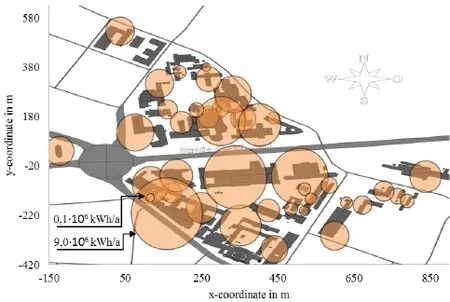
图25 / Figure 25图中圆圈表示柏林工业大学校园2012年建筑物和耗热量Overview on the University campus Berlin-Charlottenburg showing buildings and heat consumption in 2012 represented by circles
关键可持续技术3 – Diamond 3案例分析:关于德国柏林地区深层沉淀含水层地热供给情况的评估
Assessment of Geothermal Heat Provision from Deep Sedimentary Aquifers in Berlin Germany: A Case Study
2015世界地热大会的简短版本汇报
2015年4月19日至4月25日,澳大利亚墨尔本
奥利弗·卡斯特纳 朱迪思·西佩尔 甘特·齐默尔曼 恩斯特·欣格斯
Oliver Kastner, Judith Sippel, Günter Zimmermann, Ernst Huenges
为降低CO2排放量,热量供应市场需要开发一种有显著效益的可再生能源。总体来说,地热系统有着巨大潜力。然而这种潜力由于种种原因而远远未被开发:缺少地热数据导致巨大的开发风险,还包括技术挑战、高投资、有限的大众接受度等。这种情况是现实存在的,尤其表现在一些人口稠密的、高需求的城市地区,那里有着众多复杂的、需要多样化供暖的建筑设施。德国柏林就是这样一座城市。
柏林巨大的地热潜力在深处的沉淀水层中[13-14]。从地理方面探究,柏林坐落在德国东北部,这一部分的热量梯度是平稳的,但是可预测的热水资源存在于多孔的岩石中,位于1,000~5,000m深处。这一地区典型的储油层包括不同厚度组成的砂岩,这些组成中的孔隙充满不同温度的房水和盐分。这种水体可被开发利用,具备用于水热工厂系统的散热潜力:流体可通过生产井和加热提取后,使用泵加压送到地面,再由泵加压通过相应的注入井送回,以稳定地层压力(双峰系统)。一份初步评估对柏林地区的一些供热厂的热容量进行了调查分析,具体选定的位置包括前柏林滕珀尔霍夫机场[15]和柏林技术大学校园等[16]。该研究是基于一个大勃兰登堡地区的结构模型来进行的[17-19]。柏林城市中这个地区以外的地区会被裁剪,如位于联邦州勃兰登堡/德国的中心,并且计算得到的模型会与可用的附加井筒数据进行比较来校核[14]。这个柏林地区的模型解决了地热水库的主要形成规模,但是忽略体面的复杂性,产生了一些问题故障或存在不均匀性。柏林位于德国东北部盆地(图26(a)),这里中生代沉积单元的几何形状通常很复杂,可由其底层二叠纪镁灰岩盐的阶段反复变化透视图看出。上述镁灰岩盐,通常被称为Buntsandstein,展示了地下层水分包含了盐石成分,这些成分在地表上体现出多样的可渗透性。砂岩分数可以基于已知的全流域的平均值来估算,估算数据来源由从1960——1990年期间的油气勘探活动提供。更多的野外地质参数统计可以从德国东北盆地的特定时间间隔内可用字段数据中的置信区间中导出。因此,产生的结构模型的适合原则为平均属性中诱导缺少的地质精细结构的知识不确定性的评估。
我们根据一个通用的供给方案中设定的一座理想化热工厂设计作为评估地质模型。此方案的特点是使用了简单地热双峰工厂设计,如图27(a),具备标准承压含水层的条件和沿管道系统理想化的流体性质。热设备的操作被设置为优先吸收,其中一个注入井不需要泵来进行加压处理。我们提供的分析结果位于柏林技术大学校园内的位置,在图中用等高线图的白色三角“TUB”表示。地热相关的制模工厂产生热量并由机械动力消耗,来驱动泵的工作。这些高能量的供给是相关的地质参数和工厂操作的先决条件,从而设定了为散热再注入流体的温度(这里设

奥利弗·卡斯特纳(德国波鸿鲁尔大学)
Oliver Kastner, Ruhr-Universität Bochum, Bochum, Germany

朱迪思·西佩尔(亥姆霍兹波茨坦中心德国地学中心——GFZ)
Judith Sippel, Helmholtz Centre Potsdam GFZ German Research Centre for Geosciences, Germany

甘特·齐默尔曼(亥姆霍兹波茨坦中心德国地学中心——GFZ)
Günter Zimmermann, Helmholtz Centre Potsdam GFZ German Research Centre for Geosciences, Germany

恩斯特·欣格斯(亥姆霍兹波茨坦中心德国地学中心——GFZ)
Ernst Huenges, Helmholtz Centre Potsdam GFZ German Research Centre for Geosciences, Germany置为45℃),因此产生了一种很重要的技术边界条件。
图27(b)显示出柏林中部Buntsandstein地区所产生的加热功率。其幅度被预测为一个Berlinwide最大的5.9MW和包含2.9MW的平均值。然而值得注意的是,这些数字指的是地质参数和油层厚度的预期值,而在现实中,它必须再被叠加上地质模型的不确定性,这些可以在一定范围内进行估计[15,16]。加热功率的空间分布是通过温度和渗透率两个相互制约的数值支配的。温度随深度近似线性地增加,并影响所产生的孔隙流体的比焓。渗透性影响的关系与泵浦功率和生产通量率。对于位于柏林中东的Buntsandstein,模型预测的在水热资源有利区面积生产通量率为50~150kg/s,与整个大地区平均56kg相比,生产率指数与生产通量成反比,这些数值被预测有利区域之间为10~50l/(s·MPa)。生产泵工作在平均100~300kW的指标。加热功率和泵的工作(COP)之间所产生的比率达10~25。
柏林工业大学的校园坐落在一个由盐底辟引起的高层次地貌的坡面上,Buntsandstein位于较浅的深度上。所以,它表现出更高的渗透率但是在局部上更低的温度(约55℃)。相应地,预期的水库水力学允许低焓流体有更高的flx率。因为加热功率与flx率和温度的积成正比,基于中部Buntsandstein的水热厂可以产生更高的能量,其中适合的温度被升高的flx率补偿。平均上,在TUB位置这种双重系统的加热功率预计为4.5MW(假设在吸收注入良好的条件下,并且重新注射温度为45℃)。预计平均生产通量153kg/s,并且双重设计假定1,625m的良好隔离。

图26 / Figure 26柏林是德国的首都,坐落在德国东部(a), 图中显示了德国东北部盆地的沉积地质结构,包括Zechstein盐底辟构造运动时形成的显著底辟结构地貌。(b)在一个结合表面和表面物体的真实尺度视角下的柏林工业大学校园。简写:上层 (UBS) / 中层 (MBS) / 下层 (LBS) Buntsandstein,Zechstein Salt (ZS)。 地表:谷歌地球,柏林参议院城市发展和环境部。The city of Berlin is the capital of Germany and located in east Germany. (a) exhibiting the sedimentary geology of the Northeast German Basin. It comprises a landform influenced by mobilized Zechstein Salt forming characteristic diapir structures. The Campus of the Technische Universität Berlin. (b) in a true scale perspective representation combining surface and subsurface entities. Abbreviations: Upper (UBS) / Middle (MBS) / Lower (LBS) Buntsandstein, Zechstein Salt (ZS). Surface tile: Google Earth, Berlin Senate Department for Urban Development and Environment.
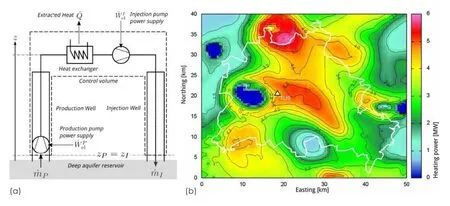
图27 / Figure 27(a)水热模型热厂的元件;(b)柏林地区挖掘中部斑砂岩含水层双水热系统的建模热动力(高斯——克吕格坐标,位于德国DHDN4区东边4,571.45km,北边5,800.3km)。柏林的边缘通过白线标出。柏林工业大学的校园通过白色三角形(TUB)标出。蓝色标注降低的热产生区域。这些分布在高海拔地区(在Zechstein盐底辟构造顶上), 储层温度达到假定回灌温度45℃。(a) Components of the hydrothermal model heat plant. (b) Modeled heating power of hydrothermal doublet systems mining Middle Buntsandstein aquifers in the Berlin region (Gauss-Krüger coordinates in km relative to 4,571.45 km easting, 5,800.3km northing, German zone DHDN4. The border of Berlin is indicated by a white line. The campus of the Technical University of Berlin is marked by white triangle “TUB”. The blue-coloured spots identify areas of reduced heat production. These are located at higher altitude level (atop of Zechstein salt diapirs), where the reservoir temperature approaches the assumed reinjection temperature of 45℃.
关键可持续技术4 – Diamond 4
废弃生物质和废水污泥的矿物质转化碳:能源生产和(或)碳汇
Conversion of Waste Biomass and Waste Water Sludges to Mineralized Carbon: Energy Generation and/or Carbon Sequestration
马库斯·安东涅蒂
Markus Antonietti

马库斯·安东涅蒂(德国马克斯·普朗克胶体与界面研究院)Markus Antonietti, Max Planck Institut für Kolloid- und Grenzflächenforschung, Potsdam, Germany
某些低价值的生物质有可能是一种非常有价值的原料来源,例如废水、污泥或者农业副产品等。因此,需要将生物质进行稳定化和矿化处理。一种被称为水热碳化的方法可以用来将材料和能源进行致密化的处理,这同时也是一种消毒、均化、一体化工艺。其产物可以说是从自然界固定碳和资源再生,因此可以认为,它在CO2平衡中起到了碳汇的作用。
1 简介
目前,我们的工业社会依赖于稳定的化石原油供应,用于能源生产、运输和化合物。石油时代的结束无疑是可以预见的,在今天人们已经能够感受到石油短缺带来的经济震荡。石油经济带来的一个更深远的影响是大量的CO2排放。由石油带来的CO2排放已达125亿吨,这同时造成了大气环境的影响和极端气候的出现。那么如何来定义一个实际有效的工具和技术?有一点很清楚,就是我们需要创造一项技术,转化由于之前发展带来的负面影响,来固化早期工业化过程中排放到大气中的CO2。我们一方面需要寻找新的碳汇,同时也需要转化一部分工业或市政产品,使之成为能够进行碳固化的产品,而不是在其整个生命周期中产生碳排放。最有利的是,如果我们已经能够在城市规划或者本地建筑的运行中集成这样的一种解决方案,那么就能够在每个城镇区或者更大的范围内为碳汇或者消除经济危机做出贡献。
2 水热碳化
2.1 废弃生物质的水热碳化for环保碳汇
最有效的和免费的CO2收集器就是自然界本身,它能够将CO2转化为一些碳致密的生物质。粗略估计,每年陆地生物质产量为1,200亿吨的干物质,其中大约有600亿吨的固化碳或2,200亿吨的等效CO2[20-21]。因此,自然界的CO2循环量仍然要比人工方式大一个数据级。正因如此,自然界能够在数亿年内保持自身的平衡。需要清楚的是,自然界产生的生物质只是短期和暂时的CO2收集,因为植物死亡后通过微生物的降解,将会释放出完全相同数量的、之前被固化在植物中的CO2。从活跃的生态系统新生成的生物质中,“仅需”8.5%重量的生物质就能够起到完全补偿原油产生的CO2排放的作用。尽管如此,也需要另外一个处理过程,来将生物质转化为煤炭、焦炭或者碳,这就是被称为“碳化”的过程,也就是将生物分子转化为富含碳的粉末。
目前的相关论证表明,不仅存在热焰碳化,也存在更为有效的“湿”碳化。类似于沼泽较为缓慢的自然过程,生物质在微酸环境中经过脱水只生成水和煤。早在1913年,Bergius和Specht就进行过这种“水热碳化”(HTC)的处理[22-23]。通过使用添加剂,更为现代的处理方法加快了这些过程,同时能够产生一些有意义的、具有特殊化学表面的微纳米材料。最终以106~109倍的加速使碳化过程的时间缩短到小时的计量尺度,因此使水热碳化技术可以集成到一些公共物质流的过程中,例如在水的循环利用中处理废水污泥或滤液,或者是园林的植被修剪以及周围的生物圈中。
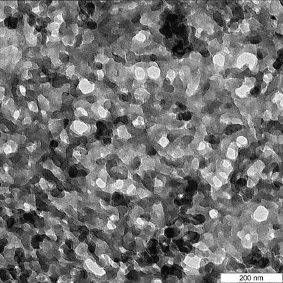
图28 / Figure 28橡树叶经过水热处理生产成的生物质型煤的电镜成像图。可以很好地观察到在20~50nm范围内的海绵状的孔型结构元素。Electron microscopy picture of a biocoal, which was made by hydrothermal treatment of oak leaves. The sponge-like pore structure with structural elements in the 20-50 nm region is nicely seen.

图29 / Figure 29从生物废弃物到生物质型碳From biowaste to biocoal
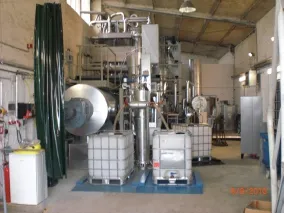
图30 / Figure 30HTC反应器HTC reactor
直接与其他生物质处理过程相比较,HTC不仅快速,而且简单有效。一方面,HTC本质上可以使用湿的原材料,因为只有在水环境中才能发生有效的反应。因此不需要进行昂贵的干燥处理过程。另一方面,HTC很容易将生物质型煤从废水中过滤出来,产品的分离是相当简单的。另一个有利的方面是,该反应是放热和自发的过程,即该过程不依赖过多的能源输入。尽管对实际的能源输出目前仍存在争论,但是根据反应过程和煤的芳构化程度,整个过程中能够释放出5%~30%燃烧原始热量。
2.2 “碳负极材料”的HTC
材料化学家目前在寻找具有潜在十亿吨级碳足迹的应用材料。在这个尺度上,一种具有吸引力的应用是将这种生物质型煤用于农业土壤的改良。从化学层面讲,这种技术相当于一个黑土自然生成的复制过程,而富含腐殖物质的土壤属于地球上最肥沃的土壤。利用化学调节腐殖物质特性的生物质型煤的发展,能够带来土壤的改良(不需要购买泥炭和有机肥来维护绿色花园或者屋顶花园),即使是在气候变化的情况下,也有助于农业领域的保护和生产力的提高。地球确实需要数十亿吨的腐殖物质。图28描述了这样一种由柏林橡树叶合成的HTC产品的内部结构[24]。这种材料结合了具有最优可及性的高性能化学表面,同时能够达到非常理想的毛细管吸水和特定的离子束缚效果,就像一个“碳海绵”。
3 讨论与结论
本章阐述了水热碳化过程以及该项技术在废弃生物质和废水污泥处理等方面的多项优势。碳化过程固定了生物质中的碳,避免生物质进一步自然降解。在本质上,通过这一过程固定的碳在CO2平衡中起到了碳汇的作用。这种新技术的原理如同植物收集大气中的CO2,并将其转化为固态碳。如果我们能够尽可能避免这种工艺的其他处理成本,例如通过使用已有的碳储存作为腐殖质来提升土壤肥力和生物附加值,那么这样的循环处理方法将是经济层面上最好的选择。
关键可持续技术5 – Diamond 5
用于在不同温度层级上存储和分配热量的低能耗区域供热和供冷技术
Low-Exergy District Heating and Cooling to Store and Distribute Heat at Different Temperature Levels (LowExTra)
马丁·克里格尔
Martin Kriegel

马丁·克里格尔(德国柏林工业大学)
Martin Kriegel, Technische Universität Berlin, Berlin, Germany
LowExTra项目将会调查和研究一种新颖的、智能的、多层区域供热网络。其目标是建立一种与今天传统的供回网络不同的新型网络,能够针对不同的温度层级实现完全灵活的调节。这个过程不仅考虑到供回的方向,还固定了管线中的温度层级。
被称为LowExTra的系统,平行于任何已有的区域供热网络,有至少4个不同层级的温度(如15℃、30℃、45℃、60℃),能够最大限度地使用环保能源(如太阳能、地热、地下水、空气等)和废物能源。特别是,低温层级允许能量来源的多元化,其中有些能量来源是以前没有使用过的。近年来在德国,伴随着LowExTra系统的应用,电力能源系统发生了翻天覆地的变化,区域供热的消费者将变成生产者。
除此之外,多层级网络在冬季和夏季都能使用。在低温层级上(在上面的例子中为15℃),可使用直接供冷系统(如表面供冷系统)。总体来说,LowExTra网络类似于建筑中常用的分层蓄热罐,是一个带有可变注入和采出量的大型蓄热系统(见图31)。
研发的该网络系统需要技术组件的动态交互,它强调将建筑和城市视为一个能源系统组件。这是一个全新的视角。
该技术的实施成果与德国提出的“能源转型2050”战略是一致的。该战略计划涉及经济、环境和社会等多个方面,其成果高度依赖于能源系统本身。智能低温网络系统的设计、实施和成功使用需要技术、经济、政策和参与等模块的交互(见图32)。
整个项目的总体目标是从技术、经济、政策和参与性等各个方面对上述多层级网络的可行性进行基础研究,并在柏林工业大学的赫尔曼里切尔学院实验室对LowExTra的关键组件进行实验测试。在这项为期3年的研究项目成功完成之后,将建立一个试验工厂。
致谢
该研究项目由德国政府资助(Bundesministerium für Wirtschaft und Energie, BMWi, FKZ 03ET1237A)。

图32 / Figure 32不同观点的交互Scheme of Interaction of the different views
关键可持续技术6 – Diamond 6使用液体干燥剂能源循环的城市温室热能供给
Heat Supply from Urban Greenhouses under Use of a Liquid Desiccant Energy Network
马丁·布赫兹
Martin Buchholz

马丁·布赫兹(德国柏林工业大学、柏林Watergy GmbH)Martin Buchholz, Technische Universität Berlin, Watergy GmbH, Berlin, Germany
在城市很多地区都存在大量的低温废热。人们希望使用这些废热,但是却缺少合适的临近集热器,并且低品质废热不适合更长距离的运输。问题的一种解决方法可以是,使用这些废热来增加吸湿液体干燥剂的浓度。
基于吸湿盐溶液的吸收材料可以应用于空气除湿过程或者从工业及建筑中回收潜热。在这种情况下,城市太阳能温室体现出应用领域最大的增长潜能。
液体干燥剂的吸水能力来源于盐溶液的热化学特性,并且在运输和储存过程中也能保持这样的热化学特性。通过吸收水分,液体干燥剂被稀释,吸水能力随之降低。当被稀释到一定程度之后,干燥剂需要再生。在加入废热之后,干燥剂近似于释放水分,部分溶液以水蒸气的形式被释放到环境之中。再生过程中适合使用的废热包括:工业生产或者发电站冷却塔及空调的废热、分布式热电联产单元以及太阳能装置等。冬季中因为室外冷空气的湿度相应较低,再生过程也可以在非常低的温度(10~25℃)下实现。通过这种方式,含水土层和近地表季节性蓄热的蓄水层可以在没有热泵的情况下使用,这与传统系统的需求不同。长达50km的网络距离通过液体干燥剂的高能源密度和储存能力被实现,从而使更多的远距离热源开采成为可能。
1 液体干燥剂的应用
1.1 太阳能温室
城市温室提供了一个特殊的应用案例。城市温室湿度很高,随着温度的升高,湿空气可以转换为干空气并用于供热。或者,热量可以被抽取并储存在干燥剂溶液内部。
通过Watergy Absorber Box,屋顶及幕墙温室可以被用于太阳能蓄热器。蓄热能力同时存在于温室空气的热量和湿度中。冬天漫射太阳辐射的温度已经达到15~20℃。通过在Watergy Box中除湿,空气温度可以升至20~28℃,然后被送入建筑中。
特别晴朗的天气中温度可以达到35℃。液体干燥剂因为从温室的空气中吸湿而被加热,可以达到40℃左右。被存储的热量可以用于晚间以及太阳辐射较低时候的建筑加热。
1.2 建筑热回收和湿度调整
建筑中的湿空气来自于住户淋浴、餐厨以及洗衣房等设备。湿度包含潜热,但往往因为房间通风而没有得到利用。为了提高能源效率和空气品质,湿度被液体干燥剂吸取用于再循环。干燥剂因为排风中的湿度而升温,反过来又被送回送风系统,对送进楼内的空气进行加热加湿。湿度的峰值被排风带走,其健康角度效益是空气的最小湿度得以持续保持。
1.3 用干燥剂和水为建筑制冷
在夏季,水可以在抽气单元中蒸发。水因为蒸发而降温。冷水先通过热交换器,再通过送风系统中的干燥剂。干燥剂因而间接冷却,并可以继续在设定状态下给送风除湿降温。
白天被干燥剂带走的热量保存在一个蓄热单元中。这一热量晚上可以被释放,而且,被干燥剂吸收的水分也因此再一次蒸发出来。在湿热的环境中,干燥剂循环网络可以提供额外的再生干燥剂。水在抽气单元中的蒸发在夜间也在继续。这使得冷量可以聚集在同一个蓄热单元里并用于第二天的制冷。一个蓄热单元因此同时用于对于热量(液体干燥剂的再生)和冷量(建筑空气调节)的保留。
2 在柏林工业大学Climate Campus的原型
根据柏林工业大学已有研究原型的经验,将会建造第一个实际的干燥剂循环网络,包括一座作为太阳能热源的城市屋顶温室,一座作为热量消耗的大学建筑和一座作为干燥剂再生的废热源的大型服务器机房。
3 对于城市热岛效应的影响和潜在的CO2减排量
目前,一般覆盖在幕墙、屋顶、停车场或其他类似地方的温室可以通过水的相变将太阳辐射转化为潜热。温室可以用于夏季表面冷却,大幅度降低屋顶表面的温度。空调的供电系统部分可以被蒸发冷却和干燥剂除湿所替代。总体上来讲,这减少了额外过程热量向环境的排放。制冷与供热的节能、温室太阳能集成以及之前未被利用的废热回收,这些都和CO2的减排潜力息息相关。
六、全文结论
在本文阐述的研究项目中,城市设计者将高效、节能且低碳的城市街区作为设计目标,这无疑对减轻气候变化影响、缓解自然资源衰减具有极其重要的价值。但本文同时指出,设计者们无法只依靠自身的力量来完成这一任务,而是必须与其他专业人员,尤其是工程师们,进行合作。“零碳”城市街区愿景的实现,需要一个真正交叉的多专业途径。
大学校园是实现这一愿景最理想的起点和试验场,因为它们整合了众多非常有利的前提条件:校园既有最理想的多专业知识储备,也有界定明确的校园区域及管理体系,还有建设完善的、贯穿社区各层级的网络系统,同时,校园还是可以与之共享理念与知识的国际科学社区的一部分。
柏林工业大学尚处于一个宏大研究发展项目的起步阶段,这一项目将塑造大学校园的未来,并蕴藏于一个更加广泛的运动之中,来共同应对节能高效与气候创新的紧迫问题。
本文开篇详细地描述了这一欧洲该领域中最为重要的联盟组织。
但是,这一泛欧洲校园联盟并不是唯一的。例如,几年前,柏林工业大学曾经成为世界城市大学网络(WC2)的成员之一。该组织由世界上12所大学构成,成员每6个月召开会议,并辅以定期的视频会议。其中,有一个名为“生态校园”的强大工作团队将其零碳校园的目标与大家分享。这展示出,“零碳校园”的课题并不仅局限于欧洲,而是世界范围的一项运动。
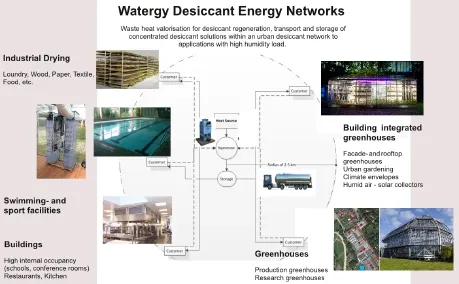
图33 / Figure 33使用废热再生干燥剂并给除湿过程提供热能的干燥剂循环Desiccant network using waste heat sources for regeneration and providing thermal energy from dehumidification processes
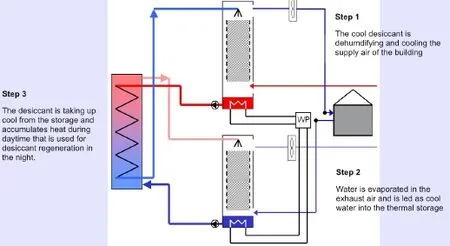
图34 / Figure 34干燥剂循环下吸湿盐溶液用于建筑制冷和除湿的系统步骤1:冷干燥剂用于除湿和冷却建筑送风步骤2:水蒸发进入到排风中并且可以冷凝蓄热步骤3:干燥剂带走冷凝热,在白天蓄热用于夜间干燥剂再生System for cooling and dehumidification of buildings under use of hygroscopic salt solutions from a desiccant network (Watergy GmbH)
ORIGINAL TEXTS
SUMMARY
This paper shows how university campuses can act as climate innovation engines and become testbeds for eco innovation and low carbon design.
It is well known that the world is suffering from climate change and natural resource depletion. Given that the building sector contributes 30%-40% of global energy related CO2emissions, consumes up to 40% of all energy worldwide and at the same time offers the most cost-effective mitigation potential[1-3], working towards the mitigation of climate change and natural resource depletion becomes an important task for urban designers and architects. However, they cannot do the job by themselves. In order to tackle a problem of such gigantic dimensions it needs an innovative interdisciplinary approach that brings not only the best people from all different disciplines together but also all different sectors of society: governments, public institutions, scientists, companies and the general public. Furthermore, to be successful, such an approach cannot be confined
to country borders but needs the establishment of strong international networks, so that knowledge can be exchanged and shared. Only in this way sustainable development can be accelerated fast enough to impact climate change and natural resource depletion in time.
University campuses are small cities in themselves. They are the perfect environments for a comprehensive interdisciplinary approach because they are not only home to the most brilliant and innovative minds of all disciplines but they are also very well connected with governments, public institutions, companies and other scientists. It is there where the future generation is educated, that will be much more adversely affected by climate change than us and will have to find solutions urgently. On campus this young generation will be involved at an early stage in the most advanced research regarding climate mitigation and learn an entire new level of environmental consciousness that will help them to find urgently needed solutions to counteract climate change and natural resource depletion and to shape a more sustainable future.
In practical terms university campuses also offer
very favorable condition as test beds: They have one homogenous ownership, their own governance, their own facility & and energy management, their own energy supply system, one well addressable user community – students, professors and employees, as well as all the necessary expertise and research capacity on site. They can act as breeding place, living lab, end-user, multiplicator and entrepreneur at the same time and thus become model and leader in climate innovation. The University Campus Berlin will be introduced and its model character as pilot sustainable urban quarter will be explained.
STRUCTURE OF THE PAPER
Networks are crucial to bundle knowledge, spread it and bring it to a higher level. Therefore, part A“A Pan-European Campus Network as Regional Climate Innovation Engines” will introduce one of the most important networks the Technische Universität Berlin (TU Berlin) is part of.
Part B describes the campus of the TU-Berlin in more detail including its challenges, goals and sustainable strategies.
PART A
A Pan-European Campus Network as Regional Climate Innovation Engines Sustainable Campus: Launching Customer (SCLC)
Francesca Cappellaro, Gertjan de Werk, Jeroen Nagel
Since an interdisciplinary approach is the key to reach maximum impact, not only the urban design challenge, but also some of the main supporting key sustainable technologies that are currently being developed at the TU-Berlin as a first step towards a carbon free campus, will be explained in brief at the end of the paper.
The European Union initiated several Knowledge and Innovation Communities (KIC) around the defined grand societal challenges. One of these challenges is climate change. Therefor the Climate-KIC was founded in 2011 and is now with over 240 organizations Europe’s largest public-private innovation partnership, working together to address the challenge of climate change. Climate-KIC drives innovation in climate change through creative partnerships large and small, local and global, between the private, public and academic sectors. Climate-KIC is organized in three different pillars; Education, Entrepreneurship and Innovation. The Innovation-pillar is divided in eight thematic platforms of which one is Making Transitions Happen (MTH). The platforms send out calls for project proposals to their community to start projects within their themes. The approach is to start with a small “pathfinder” project (approx. one year), which by success can grow to a full innovation project involving more partners and taking more time (2-3 years). Besides this the platforms run several “Flagship” projects, concerning more complex integral challenges involving more parties. This article addresses the first findings of the pathfinder project Sustainable Campus: Launching Customer (SCLC) and shows a more in-depth example of project partner TU Berlin. Thereafter we lift a corner of the veil about the application of the succeeding Innovation project Synergetic University Campuses boosting ClimatE innovationS into Society (SUCCESS), currently under review. Two partners, presented in this paper, are added in this application due to their specific expertise. To find out more about climate-KIC, please take a look at www.climate-kic.org.
1 Background
New challenges are arising for our society in relation to climate change and natural resources depletion. Fossil fuels extraction for energy, no-
renewable resources consumption, green-housegases emissions affect the development of present and future generations. There is the growing need of a radical system innovation in order to transform the un-sustainable activities and behaviors into long-term, well-being and climate-friendly systems. A trans-disciplinary approach is required in order to tackle the complexity of climate-changerelated issues and accelerating the transition to a sustainable society. Clean technologies are increasingly available, however strategies and processes to enhance the transition to economic, environmental and societal change are crucial to get these technologies to market. In this context, a transition engine influencing the direction and pace of societal change dynamics is a key factor in steering towards a low-carbon society.
2 University Campus as Test Bed for Societal Challenges
University campuses have all it takes to invent and develop sustainable system innovation: brilliant minds, international networks with governments, companies and other scientists, sufficient space,access to equipment and future generations to make innovation happen. Moreover, two important other trends are seen. First of all, nowadays universities are supposed to deliver solutions for societal problems by governments and the local community they are part of. Secondly, universities want to optimize their own operations as resources —— energy, water, waste, etc. —— are getting more expensive and government funding is decreasing. Building an effective eco-innovation system helps turning university campuses into regional climate innovation engines playing a key-role in steering towards a low-carbon society. Creating this effective eco-innovation system enhances a serious transition involving adaptations in structure, culture, organization and overall role in society of universities and campuses. Campuses can further accelerate the adoption and propagation of technological innovations into society.
This article presents sustainable transition initiatives developed by several European Campuses in the framework of the European Institute of Innovation & Technology Climate-KIC Programme. The project “Sustainable Campus Launching Customer” for example confirms universities have ambitions to play a key role in climate innovation being a regional climate innovation engine. A known discussion (http://www.sciencedirect.com/science/article/ pii/S0048733312000820) is the effectiveness of a “technology push” versus a “demand pull”innovation model. The current status quo seems to be technology push model, where this project aims to open-up the campus community to work on societal demand as input for research question to be tested in the lab, at campus and subsequently implemented back into city and society, as depicted in Figure 1.
To create an innovation model for universities in the context of the project members we have combined two existing models. A more traditional (business) stage gate decision model, in which the specific actors and processes of the university ecosystem are integrated, and the NASA Technology Readiness Levels indication as shown in Figure 2 and Figure 3.
In Figure 4 the developed Universities innovation funnel is shown.
A the bottem-arrow we introduced stage 0, the active societal demand articulation and stage 10: the widespread of an Innovation via diffusion and adoption in society. The Technology Readyness Levels (TRL) are re-defined in Innovation Readiness Levels (IRL)
The idea is to actively plot the different innovation at the different universities in this funnel, in order to simplify the exchange of knowledge between the projectpartners. A first overview of innovations and innovation-enabling-processes can be found at: www.sustainablecampus.eu/eplanete/diamonds/.
To find out more about the project and its partners, visit our website www.sustainablecampus.eu.
3 Synergetic University Campuses Boosting ClimatE Innovations into Society (SUCCESS)
As stated we would like to lift a corner of the veil about the ideas to be further developed in the innovation project. University campuses can be considered small cities —— they face similar challenges and usually approach them in the same conventional ways cities do. However, on campus the most brilliant minds are present, ready and able to face these challenges.
Our aim is to create a powerful Climate Innovation Engine: a pan-European campus network in which climate innovations are effectively developed within the local campus environments by exchanging knowledge, skills, expertise and means available. We will build the physical and virtual infrastructure to use those minds to their full potential in generating demand-driven climate innovations. This Engine will become a powerful player in the transition to a low carbon society managed by interacting Transition Teams (TTs), based on successful experience in Bologna. Naturally, successful innovations will be sold to the universities as the launching customers creating access to the whole region as potential niche markets. We will develop an innovative Campus Transition Toolkit to get and keep the Innovation Engine running. Key elements of this toolkit will be a potentially ever-expanding database, a benchmark, a dashboard and an assessment tool. See an impression of the Climate Innovation Engine in Figure 5.
The Toolkit will be developed in an interactive web-based tool in order to pick existing examples strategies, products, living lab examples etc. to accelerate the own campus sustainability strategies by fast learning, sharing, combining and optimizing proven climate innovation. See an example mockup in Figure 6.
4 From SCLC to SUCCESS, including University of Bologna and Chalmers University of Technology
A large growth of voluntary sustainability campus programs has been implemented in Europe and worldwide. All these programs help universities to commit themselves to principles of sustainability and give the impulse to start with implementing sustainability into every day processes. Next to research and education, achieving sustainability also encompasses the consideration of the university as an organization. The different and particular ways of how to bring sustainability into action could create a common knowledge that enables universities to involve the numerous actorsbelonging to university community. By pooling this knowledge of best practices, solutions and lessons learned, the transfer of experiences in a vital network becomes substantial for successful transformation of higher education institutions into places of sustainability. There is a lot of potential for further development in this field, both on the technical and the behavioral point of view.
4.1 University of Bologna (Italy): demonstrating transforming the campus into living laboratory One of the biggest Italian higher education institution, University of Bologna, demonstrates the transition approach at the Terracini Campus, underpinning to achieve sustainability at the practical applications level of the transition process. The university had already developed a Sustainability Action Plan for their own University. The adoption of transition approach helps the campus itself to develop a feedback mechanism for teaching and research practices through taking actions and at the same time building a strong sustainability community. An additional advantage of the choice of investigating sustainability initiatives at university level is revealing new considerations and contributions in the field of science of sustainability and also for the theories of sustainable transition. To create this demonstration approach three phased can be defined: Strategic, Tactical and Operational. In the strategic phase the University of Bologna set the scene for Transition Management and explored the dynamics at university level. Therefor a Transition Team was set up to engaged all the university communities: students, administrative staff and faculty. Besides, a combination of top management commitment and staff and student engagement offering the best opportunity both for successful initiation and long-term performance of university sustainability programs. The second phase is the tactical phase, in which the framing of the transition challenges and long-term visions where further developed. Following the third, Operational, phase, which we describe here more in-depth.
4.2 Operational phase in niche-experiments
The operational phase has consisted of actions and practical proposals for developing smallscale sustainable initiatives, all strictly
connected transition experiments to speed up the implementation of University of Bologna’s Sustainability Action Plan. In the transition path small-scale initiatives are called transition experiments, also known as niche-experiments. Niches have potentially path-breaking consequences when they become widely diffused and adopted. Through the conduction of transition experiments is possible to improve the awareness and to reinforce the stakeholders’ engagement. Implementing a Sustainability Plan is a way to facilitate and to connect existing sustainability best practices through the definition of targets, goals and performances on sustainability campus progress. In addition, Sustainability Plan helps to overcome the weaknesses and to improve the strengths and finally it is an opportunity to expand the existing knowledge and to introduce new sustainability issues. An approach to manage campus sustainability worth mentioning is the proposal of the International Sustainable Campus Network and the Global University Leader Forum (GULF) which have developed the Sustainable Campus Charter (International Sustainable Campus Network, ISCN, 2014). With the aim to address sustainability in holistic way, the Charter structures campus commitments about sustainability into a nested hierarchy encompassing individual buildings, campus-wide planning and target setting, and integration of research, teaching, outreach and facilities for sustainability (Figure 7).
As shown in Figure 7, the implementation of a sustainability plan could be a beneficial process which involves the whole university and beyond. Nevertheless the planning process should consist not only in monitoring the sustainability of activities, but also in creating opportunity for involving people from university community to external stakeholders. For that purpose, Terracini Sustainability Action Plan includes both technical measures and complementary actions which help to integrate governance activities in order to increase the transformative capacity of university toward sustainability. These actions comprise educational activities such as the creation of a Transition Laboratory for Students. This is a specific course where students put into practice their technical knowledge focusing on the design of specific actions
for campus sustainability. Another complementary initiatives has been the establishment of an interdisciplinary group of teachers and researchers from various Departments of the University, who share research interests in the sustainability theme. This group is named Alma Low-Carbon Integrated Research Team and involved more than 160 researchers of University of Bologna in order to integrate the multidisciplinary competences in the sustainability thematic area and to promote an interdisciplinary approach and strategic vision promoting scientific excellence.
4.3 Conclusions
We showed the case of Terracini Campus of University of Bologna as a platform for transition experimentation. Terracini campus has revealed the necessity to go beyond improvement of environmental performances and efficiency. The lack of integration of the sustainability initiatives with the real life of the campus is a constraint that limits to reach more connected and longlasting results. According with these intentions, the adoption of Transition Management within Terracini campus in Bologna has been an opportunity for a real transformation toward sustainability. We described the development of transition path which includes sustainability initiatives acting as niche-experiments of sustainability transition. The Transition process has helped to improve the awareness, to engage other stakeholders and to create new networks among different actors. As results a learning process for the improvement the transformative capacity of university toward sustainability is established. All in all, the paper demonstrates that universities can play a key role in generating concrete solutions and strategies to tackle the dynamic, complex factors fueling the sustainability crisis. With the aim to fulfil this expectation, it is essential that education, research, and societal contributions are seamlessly integrated into a combined response that is then promoted and reinforced in the process of institutionalization.
4.4 Chalmers University of Technology (Sweden): experience testing city districts sustainability demands at campus.
Chalmers University of Technology is located in
Gothenburg on the West coast of Sweden. Chalmers has some 12,000 students and 3,000 employees and is located on two campuses. Chalmers is a research intensive university with engineering and architecture education and all Masters programmes positioned internationally. Affiliated to Chalmers is the Johanneberg Science Park where knowledge and innovation go hand in hand with the associated national and international companies, as well as the municipality and region. Johanneberg has been selected as a core district in the Climate KIC Flagship project Smart Sustainable Districts, thus there are very ambitious “factor 10 improvement”envisioned in this district. The campus is an ideal test-bed for front-running innovators.
Chalmers has a sustainable campus process. This is within the Steering Committee for Campus Development led by a Vice-President and in cooperation with the Chalmers environmental office and Chalmers Fastigheter AB (the Chalmers real estate company). Chalmers recently carried out a BREEAM (way to mark the sustainability level of buildings) community beta-test which involved a wide range of stakeholders on the campus. The sustainability goals for Chalmers guide the Campus Development process. A major driving force for the campus development is the Green Travel Plan where the campus will swell with 5000 new employees (many from business and innovation) but no new automobiles.The district factor 10 process, which is ongoing, is very inclusive and involves business and society stakeholders. Within Johanneberg Science Park a number of iconic projects are now underway including Riksbyggen Positive Footprint Housing and HSB Living Lab. In terms of entrepreneurship Chalmers has three organizations dealing with student education and entrepreneurship and innovations to market. Since 2012 Chalmers is environmentally certified according to ISO 14001 with systematic efforts in education, research, innovation and internal environment and actively connecting education, research and the physical campus. Chalmers contributes to the database of ideas, innovations and tools of SUCCESS and links to the Smart Sustainable Districts resourcebox. This systems tool could then be replicated at other universities in the network.
Cooperation on specific themes, such as the low carbon vehicles (with the Swedish Volvo), with dedicated partners like Warwick and Valencia will add value to further develop and test new vehicles.
PART B1
Energy Efficient University Campus Berlin 2020 SCLC Pilot Technische Universität Berlin
Martin Kriegel, Barbara Münch, Claus Steffan, Klaus Zillich
1 Introduction
After the nuclear disaster following the accident at the Fukoshima Nuclear Power Plant in Japan in 2011, the Federal Government of Germany has decided to phasing out nuclear power in the short term and to expanding the renewable energy sector instead. This decision has since been referred to as German “Energiewende” (Turnaround in Energy Policy). The Federal Government of Germany has adopted an ambitious Energy Concept 2020 / 2050 with the aim to mitigate and adapt to climate change:
—— 2020 40% reduction of greenhouse gas emissions compared to 1990 level
—— 2020 20% increase in energy efficiency compared to 2008 level
—— 2020 increase the share of renewable energies to 18% of energy consumption
—— 2050 85%-95% reduction of greenhouse gas emissions compared to 1990 level
—— 2050 80% increase in energy efficiency compared to 2008 level
—— 2050 increase the share of renewable energies to 60% of energy consumption
In order to accelerate the implementation of its targets, the Federal Ministry of Economics & Energy BMWi has launched a research funding program with three main research foci: EnEff: City / EnEff: Campus, EnEff: Heat and EnOB (Energy Optimized Building).
The importance of this program is underpinned by the fact that about 40% of final energy is consumed by the building sector in Germany. At the same time this sector offers the most cost-effective mitigation potential, highlighting the importance of urban designers, architects and engineers in combatting climate change and natural resource depletion.
In Berlin, about 47% of the annual 21.3 million t CO² emissions in 2010 are caused by the building sector, i.e. this sector is the most important CO² polluter (see appendix “Climate Neutral Berlin 2050”[4]).
Referring to the Federal Energy Concept 2020 / 2050 the University Campus Berlin (TU Berlin and UdK Berlin) is applying for BMWi funding for the years 2015 – 2020 in order to develop its campus as a model project: Our Energy Efficient Hochschul Campus Berlin Charlottenburg, hereafter EnEff: HCBC Campus, will be developed until 2020 as an ecologically innovative and climate-friendly pioneer Berlin city quarter, but with an even more radical vision than the government program has defined. Referring to the similar goals of e.g. the city of Copenhagen with 100% reduction of CO² emissions in 2025[4], the EnEff: HCBC Campus is defining its own vision “Climate Kiez 2020”[4]with the following, even more ambitious goals:
100% reduction of greenhouse gas emission, 100% use of renewable energies, 100% increase in energy efficiency.
In March 2014 the TU Berlin has joined the above introduced Pan-European campuses network SCLC Sustainable Campus Launching Customer. Together with TU Delft and Utrecht University, TU Berlin has been appointed as “Pilot University”.
The TU-Berlin is home of two of the most prominent personalities in the field of climate change mitigation and adaption. In 2012, it has appointed Prof. Dr. John Schellnhuber, director of Potsdam Institute of Climate Impact Research (PIK), as Dr. h.c. and member of TU-Berlin.
Prof. Dr. Ottmar Edenhofer, PIK Potsdam and leading member of IPCC (Intergovernmental Panel on Climate Change), is holding the chair“Economics of Climate Change” at TU-Berlin.
2 The HCBC Campus and Its Prominent Location
The HCBC Campus forms one of four Berlin core city hot spots. The Berlin inner city urban fabric is structured by four key traffic junctions defining four main city centers: (1) Zoological Garden / City West, (2) Berlin Central Train Station / Spreebogen (north), (3) Potsdamer Platz / CBD Potsdamer-/ Leipziger Platz (south) and (4) Alexanderplatz / City East. These four Berlin city centers are qualified by four prominent and world renowned political, scientific and cultural institutions of the Capital Berlin:
—— The Sciences & Arts Campus Charlottenburg, City West,
—— The Federal Government Forum Spreebogen,
—— The Cultural Forum near Potsdamer Platz,
—— The Museum Island and the “Governing Mayor’s” Town Hall, City East.
Especially the Campus Charlottenburg is featuring unique urban qualities: HCBC is crossed by the main East-West city axis “Strasse des 17. Juni”. Moreover, the Campus is located right next to the important traffic junction “Zoologischer Garten “that is offering a perfect public transport access to the campus community, with a major long distance train station, the city train S-Bahn, the subway and the central inner Berlin Bus Station all being there. The urban core of “City West” is situated in direct vicinity of the campus, too.
The city axis “Strasse des 17. Juni” with about 120m width is intersecting the whole campus area, cutting it into a northern and southern part. In this way the north and south front of the TU Campus are facing this prominent public space of Capital Berlin, offering ideal qualities for representation and advertising (Figure 8).
Moreover, the HCBC Campus is situated in direct neighborhood of the Berlin inner-city green lungs and recreation areas “Tiergarten” and“Zoologischer Garten” making it an even more attractive location.
Regarding all these specific qualities, the university quarter EnEff: HCBC is offering excellent preconditions regarding a sustainable modernization and urbanization and is perfectly predestined as a pioneer energy-efficient city quarter.
3 The History and Status of HCBC
In 1879 the “Königlich Technische Hochschule”(Royal College of Technology) was founded by Emperor Wilhelm. II. by merging the famous“Bauakademie” (Building Academy, built in 1799 by Architect K.F. Schinkel) and the Berlin“Business-School “ (founded 1821). In 1884 it moved to a new representative Campus Building at the Charlottenburger Chaussee, today called“Strasse des 17. Juni” (Figure 9). With its focus on sciences, especially on “Mechanical Engineering”and “Electrical Engineering”, it became one of the main pillars of Berlin’s industrialization on its way to famous Berlin “Electropolis” during the last decades of the 19th and the first decades of the 20th century. Although partly destroyed during World War II, the restored building of the old “Königlich Technische Hochschule” is still used today as the main representative building of TU Berlin hosting the seat of the TU President, the administration, the Audi Max and large campus culture spaces.
Today, the EnEff: HCBC Campus is characterized by a high urban density with its approximately 50 buildings of different size, age and functions, which in total provide a built area of about 600,000 m² net floor space. The campus is hosting about 50,000 users, 40,000 of which are students.
According to the TU facility management the Campus’ building fabric is currently facing an enormous need of refurbishment, especially with regard to its energy efficiency, amounting to more than 300 Million Euro.
The Campus East, the “backyard” of the TU / UdK Berlin as well as of the City West / Zoologischer Garten, is offering a large potential of about 150,000 m² for new inner-city sustainable building space. As most of the territory is owned by TU / UdK, the site could perfectly serve as interface between Science and Economy, Research and Start-Ups, Student Living and Business Apartments.
4 The Challenge
“Our Country will be, in the best as well as in the worst case, a Global Model for the Transition from the Fossil-Nuclear to the Efficient-Renewable Economy. But without the largest city of Germany such a Transition will not succeed in a credible way” (Prof. John Schellnhuber)[4].
5 The Goal
The EnEff: HCBC Campus will be developed and promoted as pioneer of German “Energiewende”. The key goals will be a campus that in 2020 is 100% greenhouse gas emission free, covers 100% of its energy consumption by renewable energies and increases energy efficiency by 100%. In order to reach these ambitious goals the EnEff: HCBC Campus will become an “Energy Plus Quarter”, i.e. an energy producer by using an innovative mix of energy efficient plant technology. It will thus become a breeding place, test bed and engine of climate innovation, a prototype Berlin “Climate Kiez”[4].
In practical terms, the campus offers favorable conditions and characteristics to become a model for the development of a sustainable city quarter: the following facts facilitate the implementation of the pilot project: The campus has: one homogenous ownership; one elected scientific presidency; one energy supply system; one facility & energy management; one user community —— students, professors, employees; one knowledge based network of the most brilliant minds and scientists; one science-thirst-based student community.
The following focus areas have been identified to be crucial to reach the above formulated goal:
5.1 Building Fabric
The university campus is offering a high potential for saving energy and reducing CO2emissions through refurbishing the existing building stock in a radical sustainable way. The EnEff: HCBC Campus will use this potential of improving the existing building fabric in a most sustainable way. On the urban scale the eastern part of the campus will be developed as sustainable and innovative urban design including short walking distances, high density and a good connection to public transport systems. All newbuildings will be designed with a focus on energy efficiency and resource conservation.
5.2 Energy Production
As energy producer HCBC Campus will install an innovative mix of energy efficient plant technologies based on using available renewable energies on site, e.g. solar energy, deep geothermal heat, waste heat from computer centers, auditoriums etc., green cut, animal /elephant poo, black water etc.
State of the art references for this radical vision of energy-production by city quarters can be found in: a. The strategic sustainability project “Efficiency Plus” headquarters implemented by the Viessmann Group at its own production campus in Allendorf, Germany[5]; b. The Tangshan / China feasibility study “Transformation of Urban Infrastructure into Urban Public Space” by emhz Architects Berlin / Beijing, 2011[6].
5.3 Change of User Behaviour
As about 25% of energy consumption is due only to wrong user behaviour, there will be developed and tested diverse measures and practises to motivate the campus users —— students, professors, administrative staff —— to engage in acting in a responsible manner.
6 The Implementation Strategy
The main target of EnEff: HCBC Campus is to reach the goals of the German Federal Government for 2050 already in 2020.
In 2013, the final energy consumption of the HCBC Campus summed up to about 100 GWh/. This equals a primary energy consumption of 140 GWh/a.
So far, the HCBC Campus energy department has managed to continuously improve the energy and environment balance of the Campus through their active engagement in sustainable development and the implementation of active energy control systems. It is continuously minimizing its energy consumption, implementing its new “Masterplan Energy”.
As a first step in the implementation-process of the EnEff: HCBC Campus project, we will promote the following interdependent project activities, that will partly be based on currently available technologies, partly on newly developed, innovative technologies, partly on energy-efficient refurbishment of the existing building fabric and energy efficient construction of new buildings as well as on the mobilization of campus users to change their user behavior to save energy and support the sustainable change of their campus:
—— Research & development of prototype-solutions and show-cases of advanced Building-Energy-Systems in combination with energy-efficient and noise-resilient uilding skins / “Soft Sound Climate Envelopes”.
—— Interdisciplinary pilot- and demonstration projects on the levels of campus quarter, building ensembles and single buildings, focusing on“zero energy” refurbishment (e.g. Mathematics Building, Figures 10, 11, 12), energy efficient building stock enlargement (e.g. on the roof top of the main UdK building, Figure 13), and new buildings that produce energy, so called “Energy Plus Buildings” (e.g. Campus East, Figures 14, 15), thus transforming the Campus into a learning-, research- and test-lab for sustainable construction and operation.
—— Certification of outstanding prototypes of energy-saving and “Energy Plus” campus buildings with “BNB” (Federal Certificate for Sustainable Building / Bundeszertifikat für Nachhaltiges Bauen”).
—— Innovative Thermal-Energy-Management for the whole campus, shifting the boundaries of the assessment system from the single building to the area of the HCBC Campus Quarter.
—— Implementation of innovative energy efficient plant technologies on campus, either integrating them in multi-function buildings thus multiplying the use of limited space[6,7]or presenting them as stand-alone show cases (Figure 16).
—— Green Campus student activities, e.g.:
Student initiative DAEJAYON[8]: Implementation of a Bonus Model for energy saving on HCBC Campus, promotion of a GREEN CODEX for all campus users.
International student exchange and cooperation programs in order to exchange knowledge and promote awareness of climate issues.
7 Partnerships
The successful implementation of EnEff: HCBC as pioneer campus of Capital Berlin needs strong comprehensive partnerships and cooperations. Therefore, the cooperation of university, research institutes, Federal Government (BMWi), the City of Berlin and private companies is essential and promising.
Cooperating Partners from Science & Business
—— PIK Potsdam Institute of Climate Impact Research
—— GFZ Geo Research Centre Potsdam / Reservoir technologies / Deep Geothermal Energy
—— MPIKG Max Planck Institute for Colloid and Interfaces Research
—— Priedemann façade lab Großbeeren
—— GASAG Berlin
—— Herrenknecht AG, Department for research on deep drilling
8 Key Sustainable Technologies (Diamonds)
As mentioned above, an interdisciplinary, strongly integrated approach is needed in order to reach the ambitious goals of 100% reduction of greenhouse gas emission, 100% use of renewable energies, 100% increase in energy efficiency the HCBCCampus project has set itself. A key issue is to identify and tap new sources of renewable energies that are locally available on site, such as solar energy, geothermal energy, biomass (green cut of campus / park, dung of the neighboring zoo), waste heat from computer centers, laboratories, auditoriums etc. At the same time new advanced technologies have to be developed to increase the efficiency of the conversion, storage and distribution of the available renewables on site.
In the following “close look”, we will describe in more detail six selected key technologies, so called diamonds. All these key sustainable technologies are TU & TU-Partner research projects and will be part of the overall EnEff: HCBC Campus 2020 strategy:
—— Absorption Chillers for Combined Heating, Cooling and Power
—— ATES: Aquifer Thermal Energy Storage
—— Deep Geothermal Energy
—— HTC: Hydrothermal Carbonization
—— LowExTra (Low Exergy District Heating / Cooling)
—— Watergy: Heat Supply from Urban Green Houses
PART B2
Key Sustainable Technology 1 – DIAMOND 1 Absorption Chillers for Combined Heating, Cooling and Power
Stefan Petersen, Felix Ziegler
More than 25% of the space heating demand in some European countries as Germany, Sweden, Denmark or Finland is covered by district heat. Some cities in northern Europe even reach a ratio of more than 70%[9]. In summer months, most of the district heating systems in Europe are running on low capacity. On the other hand, there is an increasing demand of cooling supply for A/ C. Sorption chillers working with low driving temperatures are especially suitable for using district heat in summer to meet the demands of cooling loads. This way, the efficiency of district heating networks is improved, the provider of the heating networks encounters new key markets and the operator of the chiller obtains a cheap, reliable and ecologically worthwhile driving energy[10,11]. Sorption cooling technologies are well known as best practice energy efficient cooling supplying apparatus where heat as driving source is delivered by waste heat, trigeneration systems, solar thermal plants, etc.
A research, development and dissemination project was performed by TU Berlin with the assistance of ZAE Bayern and cooperation of Vattenfall Europe, sponsored by the German Ministry of Economics and Technology with the aim to set up high efficient absorption chillers in the range of 50-320kW. The project is continued by TU Berlin with the aid of the German associations AGFW and BTGA, TU Dresden and ILK Dresden, and again sponsored by the German Ministry for Economics and Energy.
The focus was set on an efficient system for the whole cooling generation process, including heat rejection, hydraulic components (together with parasitic energy demand) and control. An expedient capacity range was seen in 50-320kW cooling power. This is suitable for average sized residential blocks. So, in a first step a 50kW chiller was designed, built and installed in several demonstration sites. In a later step, a 160kW machine is being developed. The two types (named Bee and Bumble-Bee) are now in a field test at 16 sites in Germany.
The chiller which has been developed operates between 25% and 140% of nominal load at thermal COP’s in the range of up to 0.80 and it can deliver cold down to a part load of 5% in steady state operation. While driving heat can be used from 55°C up to 110°C at the inlet (standard operation point is at 90/72°C in/out), reject heat inlet temperatures up to 45°C are feasible for normal operation mode. The thermophysical characteristics of the first 50 kW model have been described in 2011[12].
Another important concept of the new development has been the combination with dry reject heat systems. New benchmarks in reject heat temperatures have been reached and no crystallisation problems appear at high reject heat temperatures. In part load there is a theoretical potential of saving pump energy in the reject heat cycle (see Figure 18). As defined in the European Seasonal Energy Efficiency Ratio (ESEER), around 40% of load hours are at 50% of installed capacity. Reducing the cooling water flow rate will save up to 98.5% of electric consumption of the pump if efficiency of the pump keeps constant. In addition, lowering the fan speed simultaneously can lead to parasitic energy savings of 80%-90% compared to full load if control strategies are adapted according to the findings of TU Berlin.
Adapting and enhancing the heat exchanger concept of the 50 kW model, the 160 kW concept was established. Main goals were to keep the weight of the chiller or the chiller modules below 1000 kg (stair up- and downward transportability) and size limits below 1.9m×1.6m×0.88m (floor transfer bottlenecks as doors and corner sizes). Finally, the new concept converged to figures given in Figure 21. As shown in Figures 18-20 the concept allows to divide the chiller into 2 main modules consisting each of 2 main heat exchangers, the low pressure part of evaporator, absorber, solution heat exchanger, pumps and base frame and the upper pressure vessel hosting desorber and condenser.
In Figure 21 the new chiller is compared to top market available chillers. Even as one complete system it is lighter and smaller than “one vessel”market products which are pooled in the circle. One vessel chillers are not divisible, not in weight and not in size. As a compact and complete chiller it is with only 0,86m width the slimmest chiller in this capacity range and the first one passing through doorways. Moreover, first economic analyses propose system costs to be 50%-70% lower than available by now.
In Figure 21 geometrical data of the new absorption chillers are summarized. Figure 22 gives an overview to nominal conditions of the two models.
The development described in this paper shows the potential for modernization of a seemingly mature cooling technology. Sorption cooling or heat pump systems have been a niche-market during electrification period. Within the recent discussion on energy end-use efficiency, solar power usage and combined heat and power, sorption cooling systems offer the possibility to make use of heat during summer season, and by this increase the use of cogeneration and reduce additional electric loads caused by compression cooling systems.
Acknowledgement
The authors wish to thank the German Federal Ministry of Economics and Energy represented by Project Management Jülich (PTJ) for sponsorship.
Key Sustainable Technology 2 – DIAMOND 2
Efficiency and Reliability of Energy Systems in Urban Districts with Seasonal Energy Storage in Aquifers (Aquifer Thermal Energy Storage - ATES)
Stefan Kranz, Ali Saadat, Alexander Inderfurth, Falk Cudok
Future energy systems for urban areas or urban districts require the use of energy efficient technologies and an increasing share of renewable energies. For tapping the full energy saving potential, storage of energy at different time scales is essential for compensating the time differences between energy demand and energy availability. For urban districts with high building densities, storages with large storage capacity are favorable. Especially water bearing layers (aquifers) in the underground are very suitable storages. They have been intensively proven for relatively low temperatures (10-40°C), for example in the Netherlands, and for higher temperatures up to 80°C in few individual pilot projects (e.g. Germany).
In order to make further progress on the learning curve of this technology, a new R&D project was initiated with the main objective to develop a design method leading to more reliable and efficient ATES for existing or future urban district energy systems. This project involves partners with expertise in energetic performance of buildings and urban districts from Universität der Künste Berlin, energy conversion technology and hydrogeology from Technische Universität Berlin and in geothermal technology and underground thermal energy storage technology from International Centre for Geothermal Research ICGR at the GFZ German Research Centre for Geosciences. The main example case of this project is the University Campus in Berlin-Charlottenburg (Figure 23). The campus comprises a total of 49 buildings utilized as offices, lecture halls and laboratories with construction dates spanning more than one century starting from 1883.
1 How Aquifer Thermal Energy Storages work
In ATES systems water bearing sandstones are used as storage medium for thermal energy. The groundwater serves likewise as heat transfer medium and storage medium. Common ATES systems consist of two wells or well groups (Figure 23), a“cold” well (blue) and a “warm” well (red). ATES systems are used to store thermal energy seasonally, mainly for heating and cooling of buildings. When charging the ATES system with heat, the groundwater is produced from the cold well, heated at the surface and injected into the aquifer via the warm well. During discharging the flow direction is reversed and the warm groundwater is produced from the warm well, cooled off while using the heat and injected again into the aquifer via the cold well.
2 Storage Integration and Energy System Analysis
The main objective in designing energy supply systems with seasonal energy storages is the optimal interaction of demand side, energy supply technology and storage system considering a reliable and safe operation. When developing a storage design, several influencing factors have to be taken into account. On one side, most relevant aspects are geological structure, fluid chemistry, microbiology and hydraulic and thermal properties of the storage aquifer. On the other side, there are factors determined by the surface energy systems such as the amount of energy that can be charged/ discharged, circulated groundwater volumes, temperatures and temporal behaviour of system components and demand side.
For the optimal integration of ATES into district energy systems, a design and planning method will be developed considering buildings, energy conversion technology and ATES.
3 Geochemical Aspects of ATES
The utilization of deep groundwater aquifers as energy storage is associated with possible chemical and/or microbiological interactions which may lead to a reduced storage performance. These reactions can be triggered by changing temperatures or groundwater contact with atmospheric oxygen. In order to reduce the risk of storage-misperformance, the aquifer properties and the solute transport will be investigated and characterized considering possible operating conditions. Based on these results, the effect of temperature changes on hydraulic conductivity can be qualified and temperature limits for operation can be specified. The investigations are carried out in laboratory and field experiments and supported by numerical simulations. The results are essential for a sustainable and reliable storage operation.
4 Energy Conversion Technology
In this work package energy conversion devices like cogeneration unit, compression chiller, compression heat pump, absorption heat pump, absorption chiller and absorption heat transformer are investigated. Special focus is on absorption heat converter technology. Here a new component will be developed, build up and experimentally analyzed. The absorption heat converter (heat pump type II) can be operated as absorption heat pump, absorption chiller and absorption heat transformer. Because of its large variability the heat converter is a promising technology for integrated heat and cold supply systems in urban districts.
Figure 24 illustrates a possible application for an urban district heating and cooling system with ATES. In summertime the transformer operates in absorption chiller mode and the ATES serves as energy sink to store surplus heat. In wintertime, the heat pump operation mode or heat transformer mode is active; the ATES might serve as heat source.
5 Buildings and Urban District
This work package develops a universally applicable simulation method to model the thermal behavior of an entire district consisting of numerous buildings and a versatile energy supply network. The modelling focus lies in an adequate balance of sufficient accuracy and short CPU times. Therefore, fast and simplified components are used. The simulation method will be applied to analyze different scenarios of the Campus Berlin-Charlottenburg. Figure 25 shows all buildings of the campus including the annual heat consumption.
Acknowledgement
This project is funded by the Federal Ministry of Economics and Technology (BMWi 03ESP409A). We thank the Ministry for the financial support.
Key Sustainable Technology 3 – DIAMOND 3 Assessment of Geothermal Heat Provision from Deep Sedimentary Aquifers in Berlin Germany: A Case Study
Oliver Kastner, Judith Sippel, Günter Zimmermann, Ernst Huenges
To meet the interest of carbon dioxide emission reductions, the heat supply market has to develop a significant share from renewable resources. Geothermal systems have the potential to contribute in principle, however, this potential is largely undeveloped for different reasons: Limited geological data inducing development risks, technological challenges, high invest and limited public reception. This situation is true especially for densely populated urban regions comprising high demand and complex, heterogeneous supply structures. The city of Berlin/Germany represents a prime example of this.
An enormous potential (heat in place) of the deep sedimentary aquifers in Berlin’s underground has been demonstrated[13,14]. Geologically, Berlin is situated in the Northeast German Basin, Figure 26. The thermal gradient in this region is moderate, but promising hydrothermal reservoirs are expected in porous rock formations predicted at elevated depths between 1,000 and 5,000 meters. Typical reservoir formations in the region consist of sandstone units of variable thicknesses. The pore space of these units contains aqueous fluids characterized by depthrelated temperature and salinity; this water body may be developed to utilize the heat potential by hydrothermal plant systems: The fluid is pumped to the surface through production wells and after heat extraction pumped back through corresponding injection wells to stabilize the formation pressure (doublet system). A preliminary assessment of the thermal capacities of such heat plants in Berlin has been investigated and analyzed for selected locations in Berlin, such as the former airfield Berlin Tempelhof[15]and the campus of the Technical University of Berlin[16]. The studies are based on a structural model of the larger Brandenburg area[17-19]. Out of this area, the Berlin region, located in the center of the federal state Brandenburg / Germany, was cropped and the resulting model was calibrated against additional well-bore data available[14]. The Berlin model resolves geothermal reservoirs at main formation scale, hence neglecting decent complexities like faults or present inhomogeneities at the scale of their subunits. Berlin is geologically located in the Northeast German Basin where the geometries of Mesozoic sedimentary units are typically complex because of recurrent phases of mobilization of the underlying Permian Zechstein Salt; Figure 26(a) provides a perspective view of this. The adjacent unit above the Zechstein Salt, the Buntsandstein, exhibits hydrothermal aquifers comprising sandstone sequences which are variably permeable according to the local facies. The sandstone fraction may be estimated based on the basin-wide average values known from the hydrocarbon exploration campaigns during 1960-1990. Further geological field parameters are derived statistically from available field data of the Northeast German Basin within specific intervals of confidence. The resulting structural model therefore is suited for the assessment of the principle average properties within uncertainties induced by missing knowledge of the geological fine structure.
An idealized heat plant design based on a generic supply scenario is considered in order to evaluate the geological model. This scenario is characterized by the simple geothermal doublet plant design, Figure 27(a), standard confined aquifer conditions and idealized fluid properties along the pipe system. The operation point of the heat plant is selected so as to prevail absorbing conditions in the injection well, where an injection pump is not required. Here we provide the results for the location of the campus of the Technical University of Berlin, indicated by the white triangle “TUB” in the contour map of Figure 27(b). The hydrothermal model plant produces heat and consumes mechanical power to drive the production pump. These energetic quantities are related to the geological parameters and the operation conditions of the plant. The thermal capacity is also influenced by the technical specifications of the heat supply network, which sets the temperature of the re-injected fluid after heat extraction (here: 45°C), thus imposing an important technical boundary condition.
Figure 27(b) shows the resulting heating power of hydrothermal doublet systems fed from Middel Buntsandstein reservoirs in Berlin. The magnitudes are predicted up to a Berlinwide maximum of 5.9MW and comprise a mean value of 2.9MW. Note these figures refer to the expectation values of the geological parameters and pay zone thicknesses; in reality it must be expected that these values are super-imposed by geological model uncertainties, which can be estimated within bounds[15,16]. The spatial distribution of the heating power is dominated by the interplay of two competing tendencies of temperature and permeability. Temperature increases approximately linearly with depth and affects the specific enthalpy of the produced porefluid. The permeability affects the relation between pumping power and production flux rate. For the Middle Buntsandstein in Berlin, the model predicts area production flux rates of 50-150kg s-1 in hydrothermally favorable areas, with an areawide mean value of 56kg·s-1. The productivity index, related inversely to the production flux, is predicted between 10 and 50L·s-1·MPa-1in favourable areas. The production pump working is in the order of 100-300kW on average. The resulting ratio between the heating power and the pump working (COP) amounts to 10-25.
The campus of the Technical University of Berlin is geologically situated at the slope of a salt-diapirinduced high-level landform, where the Buntsandstein is found at comparatively shallow depth. Therefore, it exhibits higher permeabilities but lower temperature (ca. 55°C) locally. Accordingly, the expected reservoir hydraulics allow high flux rates of low-enthalpic fluid. Since the heating power is proportional to the product of flux rate and temperature, a hydrothermal plant fed from the Middle Buntsandstein can reach significant power, where a moderate temperature level is compensated by elevated production flux. On average, the heating power of such doublet system at the TUB site is predicted at 4.5MW (under the assumption of absorbing injection well conditions and a re-injection temperature of 45°C). The predicted average production mass flux is 153kg·s-1and the doublet design assumes a well separation of 1,625m.
Key Sustainable Technology 4 – DIAMOND 4 Conversion of Waste Biomass and Waste Water Sludges to Mineralized Carbon: Energy Generation and/or Carbon Sequestration
Markus Antonietti
Low value biomass, e.g. from waste streams, sludges or agricultural side products, is a potentially very valuable raw material source. For that, biomass has to be stabilized and mineralized, and a process called hydrothermal carbonization can be used for densification of the material and energy content, but also as a disinfection, homogenization, and unification technology. As the resulting products can be understood as bound carbon from natural, regrowing resources, they can be counted in CO2-balance sheets on the favourable, carbon negative side.
1 Introduction
Our industrial society currently depends on a stable support of fossil crude oil, all for energy generation, transportation, and the generation of chemical platform chemicals. The end of the “oil age” is however foreseeable, and economic earthquakes preceding oil shortage are sensed already today. A further backside of oil economy is the liberation of largest amounts of CO2, and from oil alone 12.5 billion tons (Gt) of CO2are generated, with the known implications on climate and weather extremes. How could a real useful instrument or technology be defined? It is very clear that we need to create processes that are able to invert the previous developments, to bind also the atmospheric CO2of the early industrialization. We describe the search for new carbon deposits, and a part of our industrial or municipal products has to be turned into products which bind carbon rather than they generate it throughout their life cycle. Most favorably, if we could integrate such an solution already in city planning or more local building operations, each township or bigger infrastructural entity could contribute to a carbon neutral or negative economy.
2 Hydrothermal Carbonization
2.1 HTC of Biomass Waste for Environmentally Friendly Carbon Sequestration
The most effective and cost-free CO2collector is Mother Nature herself, turning it into some densified carbon species, biomass. A rough estimate of the terrestrial biomass production amounts to 120 Gt/year as dry matter, these are around 60 Gt bound carbon or 220 Gt sequestered CO2, per year[20,21]. The natural CO2-cycle is therefore still one order of magnitude larger than the anthropogenic one, just that Nature is—— for hundred millions of years —— in equilibrium with herself. It must be understood that the generated biomass is just a short term, temporal sink of CO2, as the microbial degradation after plant death liberates exactly the amount of CO2which was previously bound in the plant material. Locking away “just”8.5 wt% of the freshly produced biomass from the active ecosystem would indeed compensate for the complete CO2generation from crude oil. For all that, we need another processing step to turn biomass into coal, coke, or carbon, and “carbonization”, i.e. the conversion of soft biomolecules into a carbon rich powder, is the name for this process.
Relevant for the present line of arguments, there exists not only the hot flame carbonization, , but also a more effective “wet” carbonization. Similar to the slower natural processes in swamps, biomass is dehydrated under slightly acidic conditions creating water and coal, only. This “hydrothermal carbonization” (HTC) was performed by Bergius and Specht as early as 1913[22,23]. More modern versions accelerate those processes by additives and allow the generation of meaningful micro- and nano-structures with special surface chemistry. The finally described acceleration of coalification by factors of 106-109 down to the hour scale makes hydrothermal carbonization a technique which is worth considering to be integrated in communal mass stream, such as treating wast water sludges/ filtrates in water recycling, or for the local green cut of gardens and the surrounding biosphere.
HTC is —— in direct comparison to other biomassprocesses- not only fast, but also simple and effective. On the one hand, it inherently can use wet starting products, as the reaction only effectively takes place in a water environment. Costly drying therefore is not demanded. On the other, biocoal can be easily filtered off from the wastewater stream; the product isolation is rather simple. Another beneficial aspect is that the reaction is exothermic and spontaneous, i.e. the process does not rely on excessive energy input. The real energy output is still under debate, but depending on reaction scheme and degree of aromatization of the coal, between 5%-30% of the original heat of combustion are liberated throughout the process.
2.2 HTC for “Carbon Negative Materials”
Material chemists now look for such applied materials with potential Gt footprint. An attractive application of that scale is the use of such biocoals for the improvement of agricultural soils. Chemistrywise, this technology corresponds to a replication of the natural processes of black soils, and highly humic matter containing soils belong to the most fertile soils on earth. The development of biocoals with chemically adjusted humic matter profiles could bring soil improvement (no peat nor fertizler has to be shopped to support green or rooftop gardens) and contribute to the preservation and productivity of agricultural areas, even under altered climate conditions. The need for humic matter on this planet is indeed measured in many Gts. Figure 28 depicts the inner structure of such an HTC product, which was synthesized from Berlin oak leaves[24]. The material combines optimal accessibility with a highly functional surface chemistry and is ideally suited for the capillary binding of water and specific ion binding, a “carbon sponge” in figurative language.
3 Discussion and Conclusion
In this article the HTC process was delineated, with its many advantages to take care of waste biomass and wastewater sludges, for instance. As carbonization stabilizes biomass against the naturally occurring degradation, all carbon fixed like that is essentially on the negative side of the CO2-balance, i.e. atmospheric CO2is collected by plants and turned into solid carbon by an added technology. If we can avoid otherwise occurring disposal costs, say by using the stored carbon as humic matter to bring fertility and biological added value, such a communal cycle might even turn economically to the best choice.
Key Sustainable Technology 5 – DIAMOND 5 Low-Exergy District Heating and Cooling to Store and Distribute Heat at Different Temperature Levels (LowExTra)
Martin Kriegel
During the presented research project LowExTra a novel, intelligent, democratic multi-layer district heating network will be investigated and developed. The goal is to build a network that, in contrast to today’s classic supply and return networks completely flexible concerning different temperature levels. Not just the direction (supply or return) is dissolved in the process, but also a fixed temperature level in the pipelines.
With at least minimum four different levels (e.g. 15°C, 30°C, 45°C and 60°C), the so called LowExTra —— Low Exergy Trassen (engl. Pipelines), parallel to any existing district heating network, the use of environmental energy (solar thermal, geothermal, groundwater, air) and waste energy are maximized. In particular, the low temperature level enable to provide a plurality of power sources that were previously unused. After principle, drastic changes in the electrical energy system in recent years in Germany, with the LowExTra now also the customers of the district heating will become procurers.
In addition, the multi-level network provides summer and winter use. Due to the lowtemperature level (in the above example, 15°C) a direct cooling (e.g. over surface cooling system) is applicable. Overall, the LowExTra network is a large heat storage with variable injection and withdrawl, in analogy to the well-known stratified heat storage used in buildings (see Figure 31).
The developed democratic network requires a dynamic interaction of technological components and highlights the building and cities as an energetic system component. This is a completely new perspective.
The consequences of the implementation corresponding to the German “Energiewende 2050”in terms of economic, environmental and social aspects are highly dependent on the energy system itself. Design, implementation and successful use of “smart” low temperature networks with the possibility of decentralized supply of LowEx heat sources require the interaction of technical, economic, political and participatory blocks (see Figure 32).
The overall objectives of the whole project are the fundamental study of the feasibility of the above democratic multi-level networks from all four perspectives (technical, economic, political and participatory) and the experimental test of the crucial LowExTra components in the labs of Hermann-Rietschel-Institute of TU Berlin. After the successful completion of the three-year research project, a pilot plant will be constructed in the field.
Acknowledgement
The research project is financed by German government (Bundesministerium für Wirtschaft und Energie, BMWi, FKZ 03ET1237A).
Key Sustainable Technology 6 – DIAMOND 6 Heat Supply from Urban Greenhouses under Use of a Liquid Desiccant Energy Network
Martin Buchholz
There is a great amount of low temperature waste heat available at many urban locations. The will to use this heat exists but there is a lack of appropriate neighboured heat sinks and low tempered heat is not qualified for longer transport. The solution to this problem can be found by using the heat to increase concentrations in hygroscopic liquid desiccants.
Absorption materials based on hygroscopic salt solutions can be utilized for air dehumidifying processes and for applications to recover latent heat from industry and buildings. In this context, urban solar greenhouses represent the field of application with the greatest potential for growth.
The ability of the liquid desiccant to absorb water uses the thermo-chemical characteristics of the salt solution, which is maintained during transport and storage. Through the absorption of humidity, the liquid desiccant is diluted. The ability to absorb water thereby decreases. When a certain level of dilution is reached the desiccant needs regeneration. Under use of waste heat, it is “desorbed”, parts of the solution is released to the environment as water vapor. Industrial processes or the cooling towers of power plants, waste heat from air conditioners, decentralized co-generation units and solar power installations are suitable for the regeneration process. In winter, regeneration can also be carried out at very low temperatures (10-25°C) as the humidity of the cold outside air is correspondingly low. In this way aquifer and near-surface ground stores with seasonally stored heat can also be utilized without
the need for heat pumps as required in conventional systems. Network distances of up to 50 km are made possible by high energetic density and storability of liquid desiccant, thus allowing the exploitation of more remote heat sources.
1 Applications Using Liquid Desiccants
1.1 Solar Greenhouses
A specific application is given by urban greenhouses, as here humidity is high and humid air can be transferred to dry air with increased temperatures, allowing its use for space heating. Alternatively, heat can be withdrawn and accumulated within the desiccant solution.
With help of the Watergy Absorber Box, rooftop orfaçade greenhouses can be used as a solar thermal collector. Thermal capacities are present in both, heat and humidity of greenhouse air. During winter, temperatures reach 15-20°C already at diffuse solar radiation. By dehumidifying the air in the Watergy Box, temperature is increased to 20-28°C and then is directed into the building.
On really sunny days, temperatures reach up to 35°C. The liquid desiccant heats up as it takes up humidity from the air in the greenhouse, and reaches temperatures of around 40°C. This stored heat can then be used for heating the building during night or on days with low radiation.
1.2 Heat Recovery and Humidity Regulation in Buildings
Humid air in buildings occurs from showering, cooking, drying laundry as from inhabitants and houseplants. Humidity holds latent heat energy that is usually lost when airing the rooms of the building. In order to improve energy efficiency and air quality the humidity is taken up by the liquid desiccant in a recirculation or extraction unit. The desiccant is heated by humidity uptake in the exhaust air stream and is transported back to the air supply unit to heat and humidify the air flowing into the building. Humidity peaks are thus taken up by the exhaust air, while in the interests of health a minimum humidity is always maintained.
1.3 Cooling Buildings with Desiccants and Water
During summer water can be evaporated in the air extraction unit. Due to the evaporation the water is cooled. The cold water is conveyed over a heat exchanger and thus to the desiccant in the air supply unit. It is thereby indirectly cooled and can dehumidify and cool the supply air in a targeted manner.
Heat taken up by the desiccant during the day is retained in a storage unit. This heat can be during night and water taken up by the liquid desiccant is thereby once again evaporated. Within humid and hot environments, additional regenerated desiccant is supplied by a desiccant network. The evaporation of water in the extraction unit also continues during night. This allows cold to be accumulated in the same storage unit for use in cooling the building the next day. One storage unit is thus employed for the simultaneous retention of heat (regeneration of the liquid desiccant) and of cold (for air conditioning of the building).
2 Prototype at TU Berlin, Climate Campus Based on the experience from existing research prototypes at TU Berlin, a desiccant network, consisting of an urban roof greenhouse (as solar heat source), a university building (as heat consumer) and a large server room (as waste heat source for desiccant regeneration) will be installed as a first real built example of this kind of energy network.
3 Impact on Urban Heat Island Effect and Potential CO2Savings
Greenhouses on previously covered areas like façades, rooftops, above parking facilities or alike can convert solar radiation into latent heat due to the phase change of water. Greenhouses can be used in summer for surface cooling, strongly reducing the roof surface temperature. The electric operation of air conditioning devices can be partially replaced by evaporative cooling and desiccant based dehumidification. This in total diminishes the rejection of additional process heat to the environment. The potential for CO2savings relates to the reduction of energy consumptions during space cooling and heating, the integration of solar energy from greenhouses and the valorisation of previously unused waste heat.
CONCLUSION
The paper has highlightened the importance for urban designers to design energy efficient and low carbon urban quarters to mitigate climate change and natural resource depletion. However, it has also shown that they cannot do that by themselves but have to join forces with other disciplines especially engineers. A truly interdisciplinary approach is needed to make the vision of carbon free city quarters happening.
University campuses are the ideal starting point and test-beds for implementing this vison, because they combine a large set of very favorable preconditions: the have the best interdisciplinary expertise on site, a well-defined campus area with well-defined governance, very good established networks through all levels of society, and are part of the international science community, they can share ideas and knowledge with.
The TU-Berlin is just at the beginning of a very big research and development program that will shape the future of the campus. However, it is embedded in a much wider movement that addresses jointly the urgent issues of energy efficiency and climate innovation.
One of the most important European networks in this field has been described in detail at the beginning of the article.
However, it is not the only one. There exist many more. For example, since several years, the TU-Berlin has been member of the World City Universities Network WC2, a network of twelve universities all around the world, which meet every six months and have regular video-conferences. In this network there is a strong working group called “Eco-Campus” that shares the objectives of a carbon free campus. This shows that the topic“carbon free campus” is not only a European movement, but a world-wide one.
注释与参考文献
Notes and References
[1] Building Performance Network. Policy Paper 2013 [OL]. http://www.gbpn.org/sites/default/files/06. BuildingsForOurFurture_Low.pdf.
[2] Buildings and Climate Chance. Summary for Decision Makers, United Nations Environment Programme 2009 [OL]. http://www.unep.org/sbci/ pdfs/SBCI-BCCSummary.pdf.
[3] International Energy Agency. Transition to Sustainable Buildings, Strategies and Opportunities to 2050, Executive Summary [OL]. OECD/IEA 2013, http://www.iea.org/Textbase/ npsum/building2013SUM.pdf.
[4] Reusswig F, Hirschl B, Lass W. Climate Neutral Berlin 2050, Results of a Feasibility Study [OL]. Potsdam Institute for Climate Impact Research PIK, Senate Berlin, Department for Urban Development and the Environment, March 2014. http://www.stadtentwicklung.berlin.de/umwelt/ klimaschutz/studie_klimaneutrales_berlin/ download/Machbarkeitsstudie_Berlin2050_ EN.pdf.
[5] 在阿伦多夫菲斯曼集团总部及其生产性校园实施的战略性可持续项目“能源增值”(Effizienz Plus),在2013年已完成了德国联邦政府所制定的2050年能源与气候目标。
Strategic sustainability project “Effizienz Plus” implemented on the own headquarters and production campus of Viessmann Group in Allendorf, reaching the energy and climate goals 2050 of Federal Government already in 2013.
[6]“Transformation of Urban Infrastructure into Urban Public Space”, Berlin/Beijing 2011. Feasibility study of transformation of Tangshan Beijiao Sewage Plant into Tangshan Eco Civic Centre (TECC). Client: Tangshan City Municipality, Planning Office; Architects: Engel, Meier-Hartmann, Zhang, Zillich; Berlin / Beijing. (Proceedings 1. Chinese-German Forum for Cyclical Economy CICExpo, Qingdao, China, 08. June 2012).
[7] “The City Core as Power Plant and Civic Centre”A new dirstrict centre of “Französisch-Buchholz Nord” (Berlin-Pankow), with an innovative mix of a BHKW Block-type Thermal Power Plant, shopping, restaurants, “stacked” row houses, appartments and penthouses. Realization 2001; Client: Ottremba Berlin, and Pandion, Köln; Architects: Engel und Zillich. (published in “Solarstadt”, Norbert Fisch, Brunow Möws, Jürgen Zieger; 2001, Stuttgart, Berlin, Köln; W.Kohlhammer GmbH)
[8] DAEJAYON是一个韩国的学生倡议,在全球范围推进“自然母亲”(Mother Nature)行动。三个工作主题已被确立,包括“绿色学校”(Green School)、“绿色校园”(Green Campus)和“绿色世界”(Green World)。DAEJAYON在柏林工业大学校园内建有一个网络系统:http://www.deajayon.de。
DAEJAYON is a South-Korean student initiative, acting worldwide engaging in “Mother Nature”. Three work topics have been established: “Green School”, “Green Campus” and “Green World”. DAEJAYON has a network on the TU Campus; http://www.deajayon.de.
[9] Randløv P. Fernwärmehandbuch [M]. Fredericia: European District Heating Pipe Manufacturers Association, 1997.
[10] Naß S, Lanser W, Petersen S, Ziegler F. Einfluss thermischer Kälteerzeugung auf den Einsatz von KWK-Anlagen in Fernwärmenetzen, 11 [C]: Symposium Energieinnovationen, Graz, Austria, 2010.
[11] Zegenhagen T, et al. Best Practice: Data Center Cooling using CHCP Technology [C]: Sustainable Refrigeration and Heat Pump Technology, Stockholm, Sweden, 2010.
[12] Petersen, et al. Development of a 50kW absorption chiller [C]: Proceedings 23th ICR, Prague, Czech Republic, 2011.
[13] Kastner O, Sippel J, Scheck-Wenderoth M, Huenges E. The Deep Geothermal Potential of the Berlin Area [J]. Environ. Earth Sciences, 2013, 70(8): 3567-3584.
[14] Sippel J, Fuchs S, Cacace M, Kastner O, Huenges E, Scheck-Wenderoth M. Deep 3D Thermal Modelling for the City of Berlin (Germany) [J]. Environ. Earth Sciences, 2013, 70(8): 3545-3566.
[15] Kastner O, Sippel J, Zimmermann G. Reginalscale Assessment of Hydrothermal Heat Plant Capacities Fed from Deep Sedimentary Aquifers in Berlin/Germany [J]. Geothermics, 2015(53): 353-367.
[16] Kastner O, Sippel J, Zimmermann G, Huenges E. Assessment of Geothermal Heat Provision from Deep Sedimentary Aquifers in Berlin/Germany: A Case Study [C]: Proceedings World Geothermal Congress 2015, Melbourne, Australia, 19-25 April 2015.
[17] Noack V, Cherubini Y, Scheck-Wenderoth M, Lewerenz B, Hoding T, Simon A, Moeck I. Assessment of the Present-day Thermal Field (NE German Basin) – Inferences from 3D Modelling [J]. Chemie der Erde, 2010, 70(S3): 47-62.
[18] Cacace M, Kaiser B.O, Lewerenz B, Scheck-Wenderoth M. Geothermal Energy in Sedimentary Basins: What We can Learn from Reginal Numerics Models [J]. Chemie der Erde, 2010, 70(S3): 3- 46.
[19] Jaroch A. Stratifizierung des Hydrogeologischen 3D Modells von Berlin unter Berücksichtigung Qualifizierter Bohrungsinformationen [D]. Berlin: Technical University of Berlin, 2006.
[20] Lieth H, Whittaker R H. Primary Productivity of the Biosphere [M]. Berlin: Springer, 1975: 205-206.
[21] Bobleter O. Hydrothermal Degradation of Polymers Derived from Plants [J]. Prog. Polym. Sci. 1994(19): 797-841.
[22] Bergius F, Specht H. Die Anwendung hoher Drücke bei chemischen Vorgängen [M]. Halle: Wilhelm Knapp, 1913.
[23] Bergius F. Beiträge zur Theorie der Kohleentstehung [J].Naturwissenschaften, 1928(16): 1-10.
[24] Titirici M M, Thomas A, Yu SH, Antonietti M. A Direct Synthesis of Mesoporous Carbons with Bicontinuous Pore Morphology from Crude Plant Material by Hydrothermal Carbonization [J]. Chemistry of Materials, 2007(19): 4205-4212.
Martin Kriegel, Barbara Münch, Claus Steffan, Klaus Zillich
Translated by LIN Borong, ZHENG Xiaodi, ZENG Ying, LI Siyao
Towards a Carbon Free Campus A Pan-European Campus Network with Focus on Technische Universität Berlin
2015年2月27日
